On May 12, 1951 guitar virtuoso Carlos Montoya came to the WQXR recital studio and performed flamenco music from Granada. It was his second visit to the station in a week.
Category Archives: English
The PIDB Welcomes New Member Alissa Starzak
The PIDB welcomes a new member, Alissa M. Starzak. U. S. Senate Minority Leader Charles E. Schumer (D-NY) has appointed Ms. Starzak to a three-year term on the PIDB. The PIDB looks forward to Ms. Starzak’s participation in continuing work on transforming and modernizing the security classification system.
Ms. Starzak joins PIDB from her current position at Cloudflare, a company providing web-security and optimization services. In this position she is responsible for public policy. Prior to joining Cloudflare, Ms. Starzak worked for the U.S government in a variety of national security positions. Most recently, she served as the 21st General Counsel of the U.S. Department of the Army, after confirmation by the Senate. As General Counsel of the Army, she was the primary legal counsel to the Secretary of the Army and the Army’s chief legal officer. Her appointment as Army General Counsel followed service as the Deputy General Counsel for Legislation at the U.S. Department of Defense. As Deputy General Counsel she advised on legal issues with a legislative or congressional component, and managed an office of attorneys responsible for developing the Department of Defense legislative program.
Prior to moving to the Department of Defense, Ms. Starzak served as Counsel to the U.S. Senate Select Committee on Intelligence, focusing on legal issues relating to intelligence collection and covert action, and as an Assistant General Counsel at the Central Intelligence Agency’s Office of General Counsel. She also worked in private practice in Washington, D.C., and clerked for The Honorable E. Grady Jolly, U.S. Court of Appeals for the Fifth Circuit. She graduated from Amherst College and the University of Chicago Law School, where she served as an editor of the University of Chicago Law Review. Ms. Starzak is serving her first term on the PIDB.
Sacrifice Your Darlings
In early 2017 I posted about 25 individual daguerreotypes from the Amherst College Class of 1850 that are part of the Archives and Special Collections. I provided new glass for each daguerreotype, reassembled each unit, and attempted to identify the members of the class. The daguerreotypes were in envelopes, having been removed in the 1980s from a grouping in an old wooden frame, which was apparently discarded. With only two exceptions – Austin Dickinson and George Gould – there were no names attached to the daguerreotypes from a class well known to Emily Dickinson, who often mentioned Austin’s classmates in her letters. The identifications I proposed in the 2017 post were based in particular on things like a visible fraternity pin in a daguerreotype that could be compared against a list of known fraternity members, or later images of the students that could be compared with their youthful ones. In this way, it was possible to identify everyone at least tentatively. And there the matter rested.
A few months later I needed to write a thank-you note to someone who gave us a collection of daguerreotypes by Professor Ebenezer Snell’s brother William Ward Snell (the subject of a future post). For my thank-you, I looked through a collection of note cards in the department and chose my favorite, a photograph showing the interior of Morgan Library in the late 19th century. I’ve looked at this photograph many times, but this time – with daguerreotypes on the brain – I noticed something I’d never noticed before. Can you see it?

Look closer:
I knew at once that there was a framed group of daguerreotypes on the wall. Furthermore, it was reasonable to think it was a group of people somehow connected to each other (faculty or students) rather than a bunch of random daguerreotypes framed together (if anyone ever did that anyway). I went to a good scan of the photograph and examined it. The one on the left in the second row caught my eye — I yelped– surely that was Austin Dickinson… I wasn’t looking for him — he just stuck out in some way, perhaps because I’ve seen his big, doughy face a million times already and I have its template impressed on my brain.
My more levelheaded and therefore initially skeptical colleague Chris examined it – and agreed. It then occurred to me that if this daguerreotype showed Austin, was he where he ought to be if the daguerreotypes were in alphabetical order? I counted. He was. The next thing to do was to place the ones with solid identifications in their proper place and then to work down through the list of students. Chris and I had a lot of fun with this part.
 In order to do the work, we looked at the daguerreotypes that had some physical aspect that made them stand out – those that showed solarization in the whites that made them glow (like Faunce in the middle of the second row), or that were especially dark; those in which the direction the sitters were facing was a factor; or those that were framed in ovals, which seemed especially visible. These variables allowed us to put the images in place and recreate the framed group that you can see in the library photograph above. So here’s the Class of 1850 in alphabetical order, from left to right, top to bottom. If you want to be a smarty-pants, you could compare them with the identifications in the previous post and see where I was wrong.
In order to do the work, we looked at the daguerreotypes that had some physical aspect that made them stand out – those that showed solarization in the whites that made them glow (like Faunce in the middle of the second row), or that were especially dark; those in which the direction the sitters were facing was a factor; or those that were framed in ovals, which seemed especially visible. These variables allowed us to put the images in place and recreate the framed group that you can see in the library photograph above. So here’s the Class of 1850 in alphabetical order, from left to right, top to bottom. If you want to be a smarty-pants, you could compare them with the identifications in the previous post and see where I was wrong.

Left to right, top to bottom:
Avery, Beebe, Bishop, Cory, Crosby, Dickinson, Ellery, Faunce, Fenn, Garrette, Gay, Gilbert, Gould, Gregory, Hodge, Howland, Manning, Newton, Nickerson, Packard, Sawyer, Shipley, Stimpson, Thompson, Williston (see list of full names at end of post). Daguerreotypist undocumented but most likely J.D. Wells of Northampton.
But – oh no…!
Are you familiar with the expression “sacrifice your darlings”? I remember exactly when I first heard that expression and who said it to me. It’s usually employed (everywhere…tiresomely) as a helpful reminder to edit your writing (good advice, and I attempt to abide by it–I swear), but I also think of it in broader terms to mean giving up something one treasures. In this case, it meant that my heart must be broken and a darling sacrificed, for it revealed that the photograph below — the same photograph that is my computer’s background– is not Henry Shipley, known to his mates as “Ship,” the brilliant bad-boy of his class who couldn’t stay out of trouble and whose tragic story (see second half of earlier post) has become linked in my mind with this particular photograph:
Instead, it’s Minott Sherman Crosby, a schoolteacher and principal of two schools, the Hartford Female Seminary and then Waterbury High School, and later superintendent of schools in Waterbury. He lived to 1897 and had three children with Margaret Maltby Crosby.
This identification continues to disorder my mind and send up a bristling resistance. I still associate that face with Ship, though sadly now. Instead, the real Shipley is — according to the group order — this fellow:
So I put this guy – this Shipley – as the background on a second computer, where he duels across the room with his alter-ego (aka Crosby) for my affection. But I continue to struggle to accept the truth, which is a strange lesson in sacrificing a darling, and in how hard it is to give up a cherished belief in the face of better evidence — a lesson for every era.
So for now, at least, this should be it for the Class of 1850. Unless something else comes up….
***********************************************************************************************
Full list of the graduates of the Class of 1850:
William Fisher Avery (1826-1903)
Albert Graham Beebe (1826-1899)
Henry Walker Bishop (1829-1913)
John Edwin Cory (1825-1865)
Minott Sherman Crosby (1829-1897)
William Austin Dickinson (1829-1895)
John Graeme Ellery (1824-1855)
Daniel Worcester Faunce (1829-1911)
Thomas Legare Fenn (1830-1912)
Edmund Young Garrette (1823-1902)
Augustine Milton Gay (1827-1876)
Archibald Falconer Gilbert (1825-1866)
George Henry Gould (1827-1899)
James John Howard Gregory (1827-1910)
Leicester Porter Hodge (1828-1851)
George Howland (1824-1892)
Jacob Merrill Manning (1824-1882)
Jeremiah Lemuel Newton (1824-1883)
Joseph Nickerson (1828-1882)
David Temple Packard (1824-1880)
Sylvester John Sawyer (1823-1884)
Henry Shipley (1825-1859)
Thomas Morrill Stimpson (1827-1898)
John Howland Thompson (1827-1891)
Lyman Richards Williston (1830-1897)
There were also 15 non-graduates in the class, all of whom departed Amherst long before the daguerreotypes were made.
Pepper’s Work in Lowering Hearing Aid Costs
Recently, while engaging in a record survey project involving the Claude Pepper papers, I discovered Pepper’s influential work in lowering hearing aid costs to improve affordability and strengthen precise hearing loss screenings among seniors.

Senator Claude Pepper was perhaps the first politician to grasp the burdens of older Americans owning hearing aids. In fact, many people that were 65 and older during his congressional service either couldn’t afford hearing aids, because their insurance didn’t cover the cost, or they were exposed to fraudulent tactics to purchase them. As sellers created the illusion that hearing aids could either physically cure hearing loss or prosthetically correct hearing loss to a state of normalcy. And, in some cases, older adults fell victim to purchasing two hearing aids for both ears when only one was necessary due to a faulty diagnosis. As a result, Claude Pepper took great pride in building awareness about hearing aids and affordability by introducing the H.R. 646 Bill on January 15, 1979, to propose a supplementary medical insurance program to aid in covering hearing aid costs and safeguard consumer abuse. The bill also pushed for hearing aid manufacturers to advertise that hearing aids could not cure or impede hearing impairments. The bill demanded that the Food and Drug Administration mandate the requirement of an audiologist examination before purchasing hearing aids under the Medicare program to secure accurate treatment. Senator Pepper fought hard for this great cause, even though Congress later decided to reject the bill.
If you would like to learn more about Claude Pepper’s work regarding hearing aid legislation, please visit the Claude Pepper Library & Museum. Materials are available for researchers and can be discovered online through the collection’s finding aid.
Scotland House events at the Gold Coast Commonwealth Games
The University of Stirling Archives is delighted to be presenting Aussie Hosts and Tartan Champions, our specially curated display looking at the history of Scotland’s participation in the four previous Commonwealth Games held in Australia, at Scotland House, Team Scotland’s HQ during the 2018 Gold Coast Games. The exhibition will be on display daily from Monday 2 to Friday 6 April at the Mantra On View Hotel, Surfers Paradise, Gold Coast. Our exhibition team will be on site to provide further information about the exhibition and our work with the Commonwealth Games Scotland Archive. For more information, or to arrange a visit, please contact Karl Magee, our University Archivist, at karl.magee@stir.ac.uk

There will also be a number of events related to the exhibition during the week.
Tuesday 3 April, 11.00-12.00:
Tour and talk for members of the Australian Society of Archivists
The University of Stirling Archives invites members of the Australian Society of Archivists to a private view of the exhibition Aussie Hosts and Tartan Champions. This Australian-themed version of our touring Hosts and Champions exhibition was specially commissioned for the Gold Coast Commonwealth Games for display at Scotland House, the headquarters for Team Scotland during the competition. Karl Magee, the University of Stirling Archivist, will provide a tour of the exhibits and a talk on the development of the touring exhibition and the challenges of bringing it to Gold Coast. For further information, or to book a place, please contact Denise Stephenson, Secretary, Queensland Branch, ASA, at Denise.Stephenson@calvarycc.qld.edu.au
Wednesday 4 April, 12.30-13.30:
Aussie Hosts and Tartan Champions: a look at Scotland’s proud Games history ‘Down Under’
With Gold Coast 2018 Australia’s fifth time hosting the Commonwealth Games, Jon Doig (CEO Commonwealth Games Scotland) will turn back the clock to Perth 1962, Brisbane 1982 and Melbourne 2006 with a panel of past athletes as they share their experiences and explore the similarities and differences of competing for Team Scotland over a 40 year span. Further information can be found on Team Scotland’s Scotland House page.
Wednesday 4 April, 18.30-:
Live coverage of 2018 Commonwealth Games opening ceremony (with free Irn-Bru and Tunnocks tea cakes!)
Friday 6 April, 18.00-20.00:
Stirling University Alumni event
Join Karl Magee (University Archivist) and Prof Richard Haynes (Arts & Humanities) for a private view of Aussie Hosts and Tartan Champions and find out more about how the university is working with Commonwealth Games Scotland to protect and preserve its sporting heritage. If you would like to book a place at this event please email: Jennifer.Forman@stir.ac.uk

Our University Archivist Karl Magee & Prof Richard Haynes (Arts & Humanities) will be at Scotland House to provide tours of the exhibition.
Scotland House events at the Gold Coast Commonwealth Games
The University of Stirling Archives is delighted to be presenting Aussie Hosts and Tartan Champions, our specially curated display looking at the history of Scotland’s participation in the four previous Commonwealth Games held in Australia, at Scotland House, Team Scotland’s HQ during the 2018 Gold Coast Games. The exhibition will be on display daily from Monday 2 to Friday 6 April at the Mantra On View Hotel, Surfers Paradise, Gold Coast. Our exhibition team will be on site to provide further information about the exhibition and our work with the Commonwealth Games Scotland Archive. For more information, or to arrange a visit, please contact Karl Magee, our University Archivist, at karl.magee@stir.ac.uk

There will also be a number of events related to the exhibition during the week.
Tuesday 3 April, 11.00-12.00:
Tour and talk for members of the Australian Society of Archivists
The University of Stirling Archives invites members of the Australian Society of Archivists to a private view of the exhibition Aussie Hosts and Tartan Champions. This Australian-themed version of our touring Hosts and Champions exhibition was specially commissioned for the Gold Coast Commonwealth Games for display at Scotland House, the headquarters for Team Scotland during the competition. Karl Magee, the University of Stirling Archivist, will provide a tour of the exhibits and a talk on the development of the touring exhibition and the challenges of bringing it to Gold Coast. For further information, or to book a place, please contact Denise Stephenson, Secretary, Queensland Branch, ASA, at Denise.Stephenson@calvarycc.qld.edu.au
Wednesday 4 April, 12.30-13.30:
Aussie Hosts and Tartan Champions: a look at Scotland’s proud Games history ‘Down Under’
With Gold Coast 2018 Australia’s fifth time hosting the Commonwealth Games, Jon Doig (CEO Commonwealth Games Scotland) will turn back the clock to Perth 1962, Brisbane 1982 and Melbourne 2006 with a panel of past athletes as they share their experiences and explore the similarities and differences of competing for Team Scotland over a 40 year span. Further information can be found on Team Scotland’s Scotland House page.
Wednesday 4 April, 18.30-:
Live coverage of 2018 Commonwealth Games opening ceremony (with free Irn-Bru and Tunnocks tea cakes!)
Friday 6 April, 18.00-20.00:
Stirling University Alumni event
Join Karl Magee (University Archivist) and Prof Richard Haynes (Arts & Humanities) for a private view of Aussie Hosts and Tartan Champions and find out more about how the university is working with Commonwealth Games Scotland to protect and preserve its sporting heritage. If you would like to book a place at this event please email: Jennifer.Forman@stir.ac.uk

Our University Archivist Karl Magee & Prof Richard Haynes (Arts & Humanities) will be at Scotland House to provide tours of the exhibition.
The Journals of an 19th century Tallahassee Reverend
We recently added a small new set of materials to the digital collection for theSt. John’s Episcopal Church Records. Two items detail the history of the Church further. The other three are journals kept by the Reverend Doctor W.H. Carter. They document his travels and ministry in New York, Florida, and places in-between from 1855-1907. Dr. Carter was born in Brooklyn, New York, and studied at Yale University. Before his time in Tallahassee, Carter was rector of Episcopal congregations in Warwick, New York, and Daytona Beach. After some time spent traveling as a missionary, Carter was installed at St. John’s Episcopal Church in Tallahassee in June 1879. In his journal entry from June 9th, Carter noted: “wonder how I will like it.” He apparently liked it well enough, as he remained in Tallahassee until his death in 1907.

During his time in Tallahassee, Carter oversaw the construction of a new church building in 1880 and continued to take his clerical work on the road to worshippers in many small towns in North Florida, asylums, and the Leon County Jail. In the 1880s he was instrumental in establishing a church building and school for the black congregation of St. Michael’s Episcopal Church in Tallahassee, often performing services there. Carter’s work and demeanor left a significant impression on the congregation of St. John’s; his obituary notes that “Doctor Carter’s life was an object lesson of cheerful and patient serenity. In 1950 the church annex was extensively renovated and renamed the Carter Chapel in his honor. You may see all the journals here in the digital collection as well as the other materials digitized from the St. John’s Episcopal Church Records collection.
St. John’s is the mother church of the Diocese of Florida. It was founded as a mission parish in 1829, and the church’s first building was erected in 1837. The Diocese was organized at St. John’s in 1838 and Francis Huger Rutledge, who became rector of St. John’s in 1845, was consecrated the first Bishop of Florida in 1851. The original church burned in 1879; a new church was built on the same site and consecrated in 1888, and it is still the parish’s principal place of worship.
The physical collection includes administrative records; member registries; meeting minutes of the Vestry and church circles; Bibles, Books of Common Prayer, hymnals, and other liturgical works; documentation of the history of St. John’s Church and the Episcopal Diocese of Florida; service bulletins and other periodicals; sermon transcripts; photographs; and motion pictures.
For more information about the collection, visit its finding aid.
Sources:
W.H. Carter Journal, 1874-1897, St. John’s Episcopal Church Records, Special Collections and Archives, Florida State University Libraries, Tallahassee, Florida. http://purl.fcla.edu/fsu/MSS_2016-006
Stauffer, Carl. (1984). God willing: A history of St. John’s Episcopal Church, 1829-1979. Tallahassee, FL. http://fsu.catalog.fcla.edu/permalink.jsp?23FS021651363
Making Sunshine: The Work of the Public Interest Declassification Board
The PIDB continues its role advising the President, Executive Branch officials, and Congress on ways to bring sunshine to the security classification system in the interest of our national security. During Sunshine Week, we want to share our plans for a new report and series of recommendations we believe will transform the security classification system from its antiquated, overburdened state to a modernized system capable of functioning in the digital age.
The PIDB, forming a Declassification Technology Working Group in 2015, began conversations with government technology and information officers and experts to hear of concerns and needs in the classification and declassification frontlines. Through these exchanges and findings, we reiterate our long-held recommendation that modernization of the classification system is a critical imperative. Earnest and real attempts must be made to ensure a transparent and credible security classification system by reducing over-classification and improving declassification to sustain our democratic values and citizenry from an antiquated, overburdened system.
We know the new era must be met with a bold vision, a vision that clearly and systematically surveys the future of classification and declassification for the twenty-first century. In the next few weeks we will engage with our public and government stakeholders to share a draft report titled: A Vision for the Digital Age: Modernization of the U.S. National Security Classification and Declassification System. We will seek comments and feedback on the draft Report from our stakeholders before finalizing the recommendations and presenting to the President.
The vision we provide is for a uniform, integrated and modernized security classification system sustainable in the digital environment that appropriately protects national security interests and instills confidence in the American people. The declassification business model for the future centers on (1) organizing for success via a more unified and federated enterprise-level system-of-systems approach to records declassification and (2) the acquisition and adoption of technologies and processes that leverage information age IT and telecommunications innovation and systems development.
Our draft Report will be open to thoughtful appraisal from our stakeholders. Please remain engaged with the PIDB blog to hear more about the PIDB’s newest recommendations and to participate in the finalization of our next Report to the President.
Hosts & Champions: taking the Commonwealth Games Scotland Archive on tour
The 2018 Gold Coast Commonwealth Games begin on 4 April with a spectacular opening ceremony at Carrara Stadium, the 5th time Australia has hosted the competition. To coincide with this fortnight of sporting competition our touring Hosts and Champions exhibition is going back on the road, celebrating the history of Scotland’s participation and achievement in the Commonwealth Games.
In a first for the University Archives we will be presenting two simultaneous versions of the exhibition 10,000 miles apart during the Games, visiting Hawick Museum in the Scottish Borders and Scotland House, the headquarters for Team Scotland, in the Gold Coast.

In April 2018 two versions of our Hosts & Champions exhibition will be on display in Hawick in the Scottish Borders and at the Gold Coast Commonwealth Games.
The exhibition at Hawick Museum opens on Thursday 29 March and will focus on the Games hosted by Scotland in Edinburgh in 1970 and 1986, and Glasgow in 2014. A new display entitled Aussie Hosts and Tartan Champions has been created for the Gold Coast Games which looks at Scotland’s previous visits to compete in Australia in Sydney in 1938, Perth in 1962, Brisbane in 1982 and Melbourne in 2006. It will be on display at Scotland House (located in the Mantra On View Hotel, Surfers Paradise) from Monday 2 to Friday 6 April.
A range of tours, talks and events are being planned to coincide with the exhibitions with regular updates being posted on Twitter using #HostsandChampions.

Hosts & Champions: taking the Commonwealth Games Scotland Archive on tour
The 2018 Gold Coast Commonwealth Games begin on 4 April with a spectacular opening ceremony at Carrara Stadium, the 5th time Australia has hosted the competition. To coincide with this fortnight of sporting competition our touring Hosts and Champions exhibition is going back on the road, celebrating the history of Scotland’s participation and achievement in the Commonwealth Games.
In a first for the University Archives we will be presenting two simultaneous versions of the exhibition 10,000 miles apart during the Games, visiting Hawick Museum in the Scottish Borders and Scotland House, the headquarters for Team Scotland, in the Gold Coast.

In April 2018 two versions of our Hosts & Champions exhibition will be on display in Hawick in the Scottish Borders and at the Gold Coast Commonwealth Games.
The exhibition at Hawick Museum opens on Thursday 29 March and will focus on the Games hosted by Scotland in Edinburgh in 1970 and 1986, and Glasgow in 2014. A new display entitled Aussie Hosts and Tartan Champions has been created for the Gold Coast Games which looks at Scotland’s previous visits to compete in Australia in Sydney in 1938, Perth in 1962, Brisbane in 1982 and Melbourne in 2006. It will be on display at Scotland House (located in the Mantra On View Hotel, Surfers Paradise) from Monday 2 to Friday 6 April.
A range of tours, talks and events are being planned to coincide with the exhibitions with regular updates being posted on Twitter using #HostsandChampions.

Upcoming Cultural Events
Thanks to all who attended the HairBrained opening party on February 28th; it was a delightful evening! Remember to check the Library’s website for up-to-date information about upcoming hair-themed programming, and to pass through the Rhode Island Room on your next visit to PPL to view our exhibition.
Speaking of programming, we want to share information about two upcoming events in Providence that may be of interest to our fair blog readers:
Latinos in Heritage Conservation/ Rhode Island Statewide Historic Preservation Conference
Thursday-Saturday, April 26-28, 2018
Various locations throughout Providence
Registration required; register here before April 17.
Latinos in Heritage Conservation, Rhode Island Latino Arts, and the Rhode Island Historical Preservation & Heritage Commission are proud to present Encuentro 2018. Spanning three full days of programs in Providence and the Blackstone Valley, this groundbreaking event brings together the 3rd National Convening of Latinos in Heritage Conservation and the 33rd Annual Statewide Rhode Island Historic Preservation Conference.
Featuring guest speakers from across the country and opportunities to meet and exchange ideas with fellow practitioners and advocates for Latino historic preservation, this is a not to be missed opportunity. Rhode Island Latino Arts, RIHPHC, and local partners have planned an engaging program of tours and special events to round out the schedule.
RISD unbound Art Book Fair
Saturday, April 7, 2018
Fleet Library at the Rhode Island School of Design
15 Westminster Street, Providence, RI
Free and open to the public
This day-long event celebrates artists’ books, zines, and experimental printed matter created by RISD students and local artists, designers, and publishers. Through exhibits, sales, and discussions, RISD unbound seeks to inspire unbound conversations around cultural publishing in the Providence community.
Finding Angel de Cora
I have spent a lot of time digging a little deeper into our Native American Literature Collections in preparation for the Rare Book School course I will be co-teaching this summer: A History of Native American Books & Indigenous Sovereignty. I was already aware of Angel de Cora(Winnebago) and her work as a book designer and illustrator, and I knew she went to school at Smith, but not much more than that.

Francis LaFlesche. The Middle Five. Cover design by Angel de Cora.
My Rare Book School co-conspirator, Amherst Professor Kiara Vigil, told me to read this book, which includes a whole chapter on de Cora:
Hutchinson’s book fleshes out the broader context in which de Cora was working, and she identifies other examples of de Cora’s commercial illustration work. Learning that de Cora attended The Drexel Institute of Art in Philadelphia where she studied under famed American illustrator Howard Pyle helped to place de Cora within the mainstream of commercial illustration work in the 1890s. Two of her earliest known published works fit neatly within the pages of Harper’s New Monthly Magazine, which was aimed at the rising American middle class consumer. Her first story, “The Sick Child,” appeared in the February 1899 issue:

A second illustrated story appeared in the November 1899 issue of the same title: “Gray Wolf’s Daughter”:

Chronologically, de Cora’s illustrations and designs for The Middle Five followed in 1900. In addition to the cover shown above, de Cora produced a color image for the frontispiece, with her signature clearly visible at the bottom:

Before reading Hutchinson’s book, I was not aware that de Cora took a job at the Carlisle Indian School — a boarding school for Native American students in Pennsylvania — where she taught art for several years. While at Carlisle, she also helped launch a new magazine called The Indian Craftsman, a reference to Gustav Stickley’s arts and crafts movement magazine, The Craftsman. Although Amherst College does not hold any original issues of The Indian Craftsman, there are several available through the Carlisle Indian School Digital Resource Center:

As soon as I learned of this magazine, and others produced at Carlisle, I began searching for more information about printing projects at Carlisle and other Native boarding schools. As luck would have it, a book appeared last year on that very subject: Recovering Native American Writings in the Boarding School Press (Edited by Jacqueline Emery).
More than simply a working artist who incorporated her Native heritage into her work, de Cora was attempting to develop a pan-Indian aesthetic that blended her formal training and Native traditions.
Food and Drink: New Video Wall Show
Over the past several years, five video wall shows centering on various themes have been created at the Archives. Titles include Vancouver Vignettes, Games in the City, Edifice, Forces Shaping a City, and Parks. The video wall shows highlight the diverse nature of our photograph, video, and textual holdings.
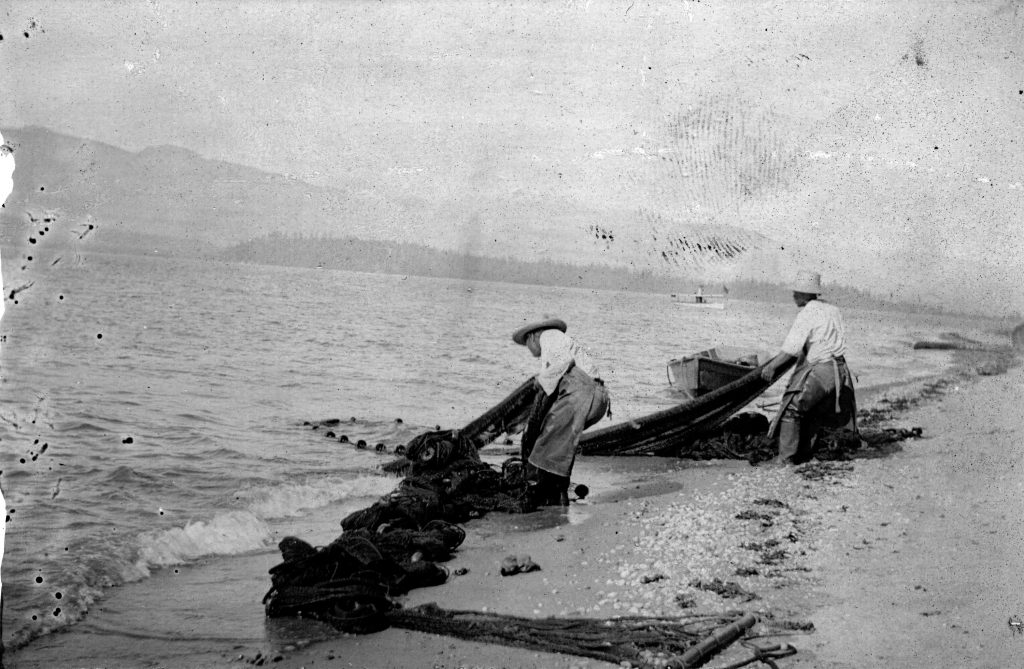
One of the photographs included in the video wall show. Fishing on Greer’s (now Kitsilano) Beach, 1890s. Reference code: AM54-S4-: Be P142
It has been a few years since the last video wall show, Parks, was created, so we felt it was time to add another one to our rotating shows. We are happy to announce the latest show: Food and Drink: Growing, making, buying and consuming.
The inspiration for this latest installation was two-fold. As an undergraduate, I studied horticulture and agriculture, and therefore the production and consumption of food and beverages are never far from my mind. Secondly, in my daily work at the Archives, I constantly come across a wealth of materials relating to the production and consumption of food and beverages in and around Vancouver throughout the last 150 or so years.
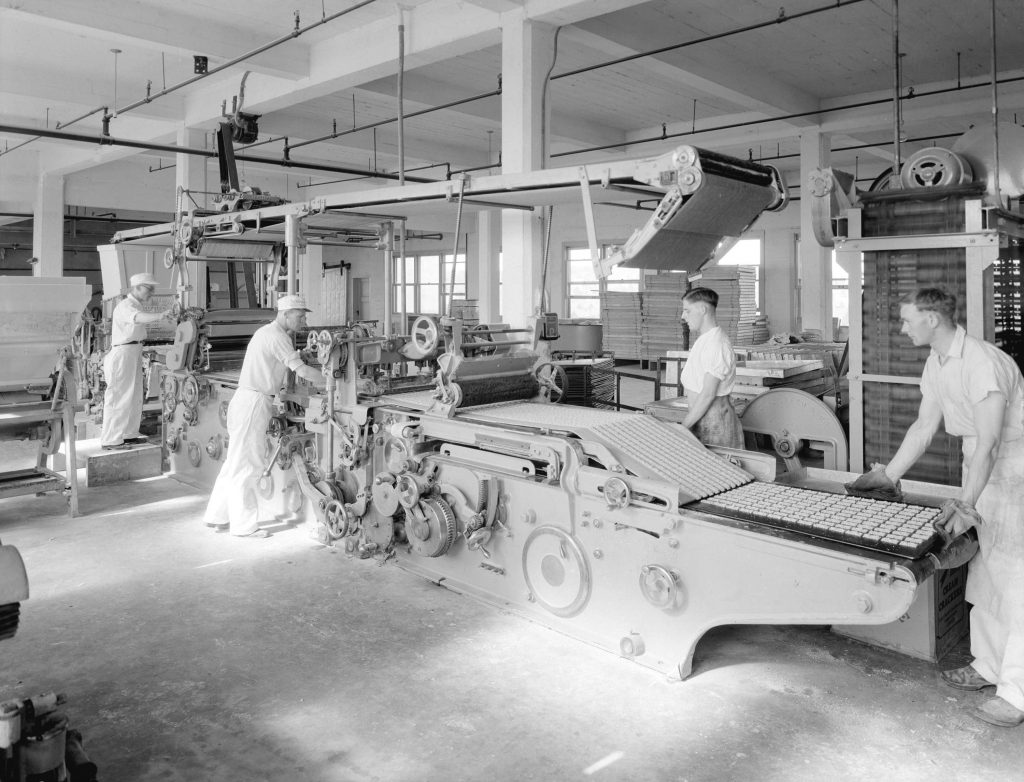
A photograph included under the Making and Processing Food section of the new video wall. Interior of the National Biscuit Company, 1931. Reference code: AM1535-: CVA 99-3983
The creation of a video wall show is a lengthy process which requires a fair amount of researching materials and refining the theme’s framework. However, it is a very satisfying process that has provided me with an opportunity to be creative all the while increasing my knowledge of our collection and the history of Vancouver, something that always comes in handy when assisting our researchers.
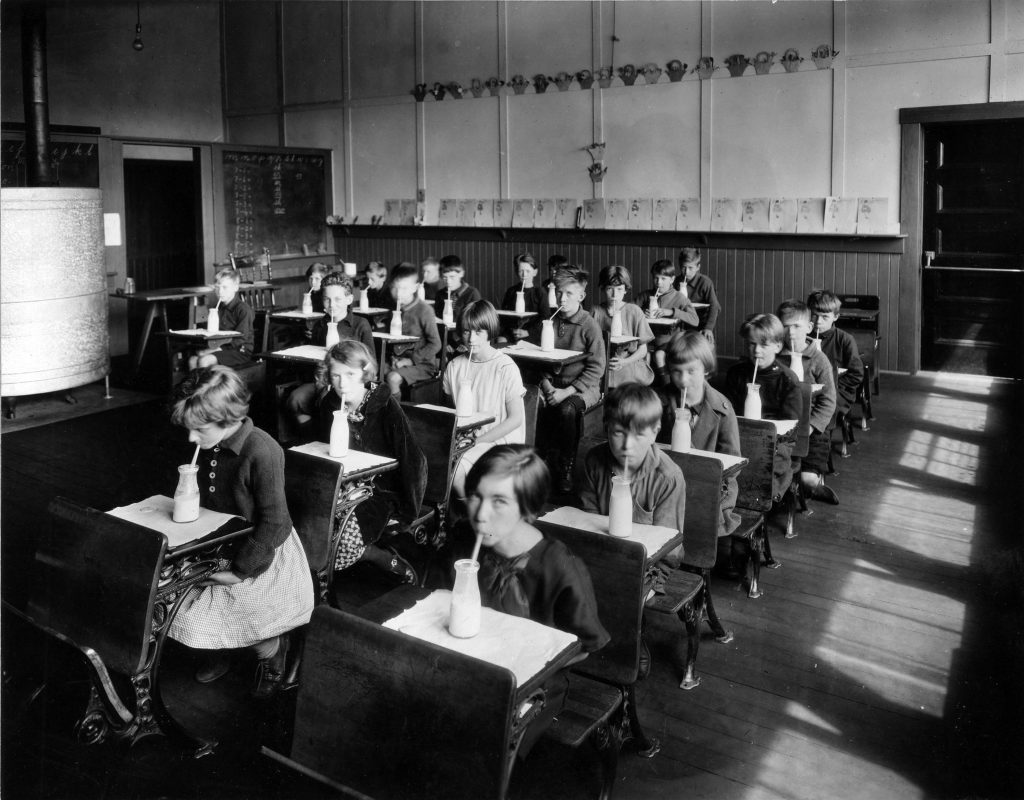
Another image featured in the new video wall show. Children drinking milk in classroom at Open Air School, ca.1926. Reference code: AM1376-: CVA 96-2
The video wall show starts with the raising and growing of food, then transitions to the making and processing of food and beverages, the buying of food, and finishes with photographs related to the consumption of food and beverages. The video wall shows can be viewed at the Archives in our gallery space, or in the City Hall rotunda across from the elevators. You can also view it on YouTube.
Celebrating Information Access: Sunshine Week 2018
Sunshine Week is an annual nationwide celebration of access to public information. It was launched more than a decade ago by the American Society of News Editors, and is embraced by journalists, librarians, concerned citizens, civil society organizations, elected officials, and government employees as an opportunity to discuss the importance of open government and its impact.

The National Archives and Records Administration will host several events in observance of Sunshine Week. Events include an educational symposium, a week-long transcription challenge engaging citizen archivists, and a panel discussion. Sunshine Week allows the National Archives to highlight how it is a leader in open government.
Sunshine Week 2018 at the National Archives will begin with a special program on Monday, March 12, 2018, at 1 p.m. in the William G. McGowan Theater in Washington, DC. Senator Patrick Leahy of Vermont will offer the keynote address entitled “Championing The Public’s Right to Know.” Several breakout sessions featuring government leaders and experts will focus on innovation in the Federal Government, congressional digital engagement, and open data.
Throughout Sunshine Week, the National Archives will also sponsor a special citizen archivist mission focusing on transcription of the Pentagon Papers, starting on March 12. The Citizen Archivist Dashboard offers more information on how to engage in the transcription challenge.
To round out the Sunshine Week events, the National Archives will host a panel discussion entitled “Access and Transparency—Records Held at the National Archives” on March 14, 2018, at 2 p.m. in the William G. McGowan Theater in Washington, DC. The program focuses on how to request and access the restricted and non-restricted Federal records held at the National Archives. The panel of staff experts will discuss and answer questions about their work in making records available from our executive, legislative, and Presidential holdings.
The National Archives Sunshine Week events are free and open to the public, but registration is required for the March 12 event. The program will also be available via livestream from the National Archives YouTube Channel.
Learn more and find the full program of events on the FOIA Ombudsman blog.
Solidifying U.S.-Czech Relations
“Dobrý den!” Or, as we in the Czech Republic say, “hello!” Over the past few months, I have been working on creating a container list for the Talbot “Sandy” D’Alemberte Collection. Talbot “Sandy” D’Alemberte, a Tallahassee native, is a lawyer, professor, and former President of FSU. A former President of the American Bar Association, Sandy is well known throughout the legal world and has made important contributions in promoting equality and democracy. Special Collections & Archives received these materials recently, and it has been my job to help organize and categorize all of the materials in the collection. Despite the preponderance of legal files, case briefs, and writs of certiorari, there have been a few interesting finds in the collection.

In particular, I am intrigued by Sandy’s connections with the American Friends of the Czech Republic, a group designed to increase relations between the United States and the Czech Republic. Sandy was a board member of the group and oversaw the erection of a statue of T.G. Masaryk, who was the first president of the now extant country of Czechoslovakia. Most of the materials pertaining to Sandy in this part of the collection are site proposal documents and information on the Resource Development Committee of the American Friends of the Czech Republic. I find this particular part of the collection interesting for two reasons: first, given that my family heritage stems from Slovakia in a tiny town near the Czech Republic, it is always wonderful to pour over and analyze information from my ancestral homeland; second, and more importantly, Sandy’s work with the American Friends of the Czech Republic reifies his overall drive to be amicable, and most of all, helpful. This notion is further peppered throughout the entirety of the collection, particularly in his extensive and lengthy list of Pro Bono hours and in his service in and on multiple commissions, organizations, and commissions designed to improve access to education and to basic, fundamental resources.
Further, I believe that this part of the collection comments on a common undercurrent of the D’Alemberte Collection, that is, that despite our differences, we, as a human race, are profoundly more similar than we might believe. Ultimately, I am quite honored to be working on this collection and to have come to know, vicariously, such a reputable member of the FSU community.
Post by David Advent. Advent, a native of Western North Carolina, is a junior English Literature and International Affairs double major at FSU. He is currently conducting his Honors in the Major Thesis and holds numerous campus positions that promote the visibility of undergraduate research at FSU.
Make Access Happen
The National Archives and Records Administration has been able to accomplish some incredible digitization and outreach work over the years due in part to contributions and support by anonymous donors and the National Archives Foundation. Two examples of this are the World War I Wartime Films project, and the Ratified Indian Treaties vault digitization project.
Wartime Films: World War I
The digitization of WWI-era material, much of it never-before-seen by the public, was made possible through the generosity of an anonymous donor. This digitization effort included over 100,000 photographs and several hundred reels of film originally shot by the US Signal Corps on behalf of various armed forces units in the 1914–1920 timeframe. All material digitized is now available online in electronic format the National Archives Catalog.
To better engage and connect our audiences to this extensive collection of World War I resources, NARA developed the Remembering WWI mobile app. This app provides users with a way to interact with the content and was designed for a target user group of teachers, museum professionals, and digital humanities scholars. We wanted to reach teachers in hopes that the app could enhance lessons on WWI in the classroom, museums to reuse NARA’s WWI materials to enrich the narrative around their own local WWI collections and exhibits, and humanities scholars so they can utilize and reuse the metadata that were generated from this content.
We were recently informed by James Theres (Filmmaker, Producer, and Director) that he helped to produce new documentary called “The Hello Girls” which reuses much of our still images and silent films for his documentary.
NARA was fortunate to lead this national collaborative effort with participation from the Library of Congress and National Museum of American History, Smithsonian Institution – National Museum of American History, the WWI Centennial Commission, the American Association of State and Local History, and the National WWI Museum and Memorial. This collaboration will ensure our audiences are connected to an extensive collection of resources to further provide an enriched experience with the app.
Vault Digitization: Ratified Indian Treaties
Some NARA holdings are so historically significant and valuable that they are separated from our normal holdings and stored in vaults to increase security and limit physical access. Vault materials at our Washington DC location are among the most sensitive records in NARA’s collection: these records are not served to the public. Many of these records have not been digitized and are therefore effectively closed to the public.
With support from an anonymous donor and the National Archives Foundation, NARA is embarking on an effort to digitize the set of Ratified Indian Treaties from our vault holdings (377 treaties in all). NARA will perform much needed conservation work on these materials and digitize the entire contents of the file for each treaty. This will include scanning the Treaties themselves along with accompanying papers: the Presidential Proclamations, and the Resolutions of Ratification by Senate. We will finally be able to provide public access electronically to these materials on our National Archives Catalog. Having this content available publically further compliments NARA’s existing education efforts around the treaties and other Native American records.

Sample image from the Ratified Indian Treaty 133: Arikara (Ricara) – Arikara Village, July 18, 1825. National Archives Identifier 57698865
![Sample image from the Ratified Indian Treaty 360: Sioux (Sisseton [Sissiton], Wahpeton [Warpeton]) - Washington, DC, 1867.](https://i1.wp.com/aotus.blogs.archives.gov/wp-content/uploads/2018/03/58234673.jpg?resize=356%2C777&ssl=1)
Sample image from the Ratified Indian Treaty 360: Sioux (Sisseton [Sissiton], Wahpeton [Warpeton]) – Washington, DC, 1867. National Archives Identifier 58234673
We are also working closely with the Smithsonian National Museum of the American Indian in support of their Nation to Nation exhibit. Starting in 2014 and rotating every 6 months, NMAI is displaying a new treaty to be exhibited to the public. Most recently, the Treaty of 1868 with the Navajo was installed on February 20th and will be on display at NMAI until May. It will then be on loan to the Navajo Nation Museum in Window Rock Arizona in time to commemorate the 150th anniversary of its signing.

Sample Image from the Treaty between the United States Government and the Navajo Indians Signed at Fort Sumner, New Mexico Territory on June 1, 1868. National Archives Identifier 6173067
Our efforts in digitization are an important piece in achieving our strategic goal to Make Access Happen. Through these generous gifts, we are able to expand our digitization and online access efforts to make these public domain records more accessible for everyone to use, from teachers and local community groups, to museums and filmmakers.
Take Me Out To the Ball Game…
In Florida, it’s easy to see how it’s baseball season. We’re coming out an unusually warm February (though more seasonably cool and rainy weather is headed our way). So, it came as no surprise that the college baseball season is already in full swing. The 2018 Noles are riding a winning streak going into the second month of the season, having won their first 8 games of the season. Perhaps they’ve been perusing our collection of media guides from past teams for inspiration in the offseason.

FSU has the dubious honor of being the most successful collegiate baseball program in the United States without a College World Series championship to their name. Maybe this will be their year? We wish them luck!
Browse our entire collection of sports media guides for FSU athletics here and if you have some you see we’re missing, let us know! We’d love to complete our collection.
Journeys in the Shaw Collection: Bohemian Grove Plays
The Green Knight
FSU’s John M. Shaw Childhood in Poetry Collection is vast and covers myriad topics. While most are books intended for children, or books containing poetry, or both, in many cases the texts deviate from the collection’s title altogether.

Such is the case with The Green Knight: A Vision. In a catalog search for children’s books about knights, I stumbled upon a work that, with a little research, unraveled into a fascinating story about powerful men meeting in the woods in secret. The book is tan with a white spine and a gold medallion on the front cover depicting two knights astride their horses in the middle of a joust.

The Naked Man
The first sign that the text might not be intended for children was this strange photograph, labeled “NEOTIOS.”
It is a naked man, from a distance. Though the photograph is pasted into a position clearly made for it – the name of the photograph and artist are printed in the space below the paste-in spot – it is a strange sight opposite the elaborate title page, with its wood-block border and inclusion of green ink.

It is on this frontispiece that The Green Knight’s origin is identified: “PRIVATELY PRINTED FOR THE BOHEMIAN CLUB BY SOME OF ITS MEMBERS / SAN FRANCISCO: MCMXI.” The border incorporates the primary values of the Bohemian ideal in the four great arts: Music, Literature, Painting, and Sculpture. Nature and Bohemia are at the top, and Care, the personified troubles and worries of the world, is at the bottom and depicted as a skull. (The Bohemian Club famously burns Care in effigy at a secret ceremony during their time at the Bohemian Grove.)
Weaving Spiders

The Bohemian Club is a private club (still active) founded in 1872 in San Francisco. The club began in order to gather together creatives in a sort of “salon” setting, but eventually included influential businessmen and politicians who considered themselves art aficionados. It is perhaps more accurate to say that they were aficionados in so far as they had the resources and leisure to enjoy and own art at a level beyond that of the everyman. The club’s motto is “Weaving spiders come not here,” meant to indicate that the wheeling and dealing of business should be left outside the walls of the club, where the conversation should turn to loftier things like art, music, and literature. However, it is undeniably a community of movers and shakers, and membership rosters read like a who’s-who of the era.
“Oscar Wilde, upon visiting the club in 1882, is reported to have said “I never saw so many well-dressed, well-fed, business-looking Bohemians in my life.” (Wikipedia)
Bohemian Grove

Each summer, the Bohemian Club gathers in a second location outside of the city, among the redwoods of Monte Rio, California in what came to be called The Bohemian Grove. Here, global leaders purportedly “rough it” in the woods, but from accounts, it seems that the modern concept of “glamping” (glamorous camping) is a more appropriate description.
During the final weekend of a three-week stay in the Bohemian Grove, an elaborate play is performed: the Grove Play. It is written and staged entirely by club members. The Green Knight: A Vision is one of these plays, performed only once in the forest of the Bohemian Grove and recorded in this book that was meant only for the eyes of its members. The picture of the naked man is a character in the play, Neotios, whose proposed costume is depicted in the book.
Grove Plays always incorporate a musical component, and The Green Knight includes the composed music, which is primarily instrumental and meant to break up the sections of speech. There are a few chanted portions, highlighting the ritualesque nature of the performance.

The Sire
The book includes an introduction by the “sire” (author) Porter Garnett, the play text, costume designs, music, and a fold-out map of the natural stage: a hillside faced by log benches for the spectators. It is this hillside that is depicted in the photograph of Neotios. The Bohemian Grove performances aspired to a level of artistic excellence that was unsurpassed outside of the private gatherings. Porter Garnett argued that “a certain number of the audience – by reason of their possession or their apprehension of it – feel that they are participants in a rite, not spectators at an entertainment” (The Bohemian Jinks ix).

Plays performed by Bohemian Grove members were referred to as “jinks,” and other copies of “Summer Jinks” exist, even here at FSU. The Allen Music Library holds a copy of “The Atonement of Pan: A Music Drama” from 1912, and Special Collections has Truth: A Grove Play from 1926 in its vault.

For further reading on the Bohemian Grove, this Vanity Fair article is a fascinating introduction.
SOURCES:
Garnett, Porter. The Bohemian Jinks : A Treatise. San Francisco : Bohemian Club, 1908., 1908.
Garnett, Porter and Edward Griffith Stricklen. The Green Knight : A Vision. San Francisco, Priv. print. for the Bohemian club, by some of its members, 1911.
Hadley, Henry and Joseph D. Redding. The Atonement of Pan : A Music Drama. [San Francisco, Calif. : Bohemian Club], 1912.
Sterling, George and Domenico Brescia. Truth : A Grove Play. San Francisco : Bohemian Club, 1926.
HairBrained Kickoff Party
In case you haven’t heard, tomorrow (Wednesday, February 28, 2018) is the kickoff party for our 2018 exhibition and program series, HairBrained! The event runs from 6:00-8:00 here at the library, and will feature curators’ tours of the exhibition, an interactive performance from our Creative Fellow Becci Davis, and a performance by Sussy Santana and Orlando Hernández. The opening is also a great chance to get a copy of our exhibition catalog, which features color photos of exhibition items alongside hair-themed poetry by Sussy Santana.

We’re excited that opening day is nearly here. We’ve spent months carefully selecting items, researching everything from ancient Egyptian wigs to the history of the hooded hair dryer, building a fleet of custom book supports, and printing labels.

These book supports are made of black, acid-free matboard that is cut to the measurements of each item in the exhibition.
Meanwhile, our Director of Programs and Exhibitions has been planning a fantastic series of hair-themed programs to take place at the library during the upcoming months. You can see a list of upcoming programs on the PPL website.
NHPRC and Andrew W. Mellon Foundation Launch Digital Publishing Initiative
On February 14, we made a great match. Together with the Andrew W. Mellon Foundation and our own National Historical Publications and Records Commission, we announced the eight planning-grant recipients for our joint Digital Edition Publishing Cooperatives Program. These eight cooperatives will test out new ways of making historical records more readily accessible to scholars, students, and the American people.
Our business since 1934 has been not only to preserve records but to provide public access to them. Rather than sitting in boxes (or up in the cloud), records are most valuable when they are used.
That’s the whole point of the National Historical Publications and Records Commission: to find the best ways to make historical records public, to enable people to easily find, understand, and use the primary sources to tell the American story. Through grants by National Historical Publications and Records Commission (NHPRC), the National Archives has for decades played an essential role in building the nation’s historical infrastructure, funding hundreds of archival projects, microfilm editions, and some of the nation’s most important documentary editions in print and online.
Perhaps the best example is our long-time support of six major Founding Fathers projects, first through bound print editions available at libraries but now freely available via Founders Online.
Other projects like the Freedmen and Southern Society Project and the papers of Thomas A. Edison, Eleanor Roosevelt, and Martin Luther King, Jr are also exploring new ways of doing time-honored work.
This new NHPRC-Mellon partnership will help more documentary editing projects navigate the ongoing transformation from print to digital publication. Individual scholarly editions continue to find it difficult to build and maintain their own digital infrastructure for creating and disseminating their work, and most producers of digital scholarly editions lack access to predictable, affordable, and sustainable publication channels. That’s why, in fall 2016, NHPRC staff convened a working group on “Building a Sustainable Digital Edition Ecosystem” for the Mellon-funded Scholarly Communications Institute, held each year at Duke University. The TriangleSCI working group included historians, documentary editors, archivists, digital humanists, programmers, and university press / library publishers. Each brought new insights for building a sustainable future for the digital edition.
The NHPRC-Mellon Digital Edition Publishing Cooperatives Program, which we first announced in 2017, was a direct outgrowth of their deliberations. The initiative is notable for several reasons. First and foremost, it “does not seek to create or impose a specific framework or platform. Rather, it proposes a process for project teams to build—from the ground up rather than from the top down—a cooperative infrastructure for publication based on their own needs and capacities.” Further, the initiative seeks ways to “exploit the synergies among editions” that “enable them to interact.”
True to the vision of the TriangleSCI working group, the “infrastructure” includes more than just “technological systems (such as digital repositories or discovery tools).” It also includes human infrastructures–“shared standards, semantics, practices, and policies”–that can only be arrived at through discussion and compromise.
Recognizing that “modern digital scholarly editing practice does not take place in isolation,” the initiative addresses issues of longstanding concern here at NARA and in archives across the nation. How can digital editions take advantage of shared information resources–such as the Social Networks and Archival Context (SNAC) Research Tool, which is addressing a long-standing research challenge: discovering, locating, and using distributed historical records? A key premise of the initiative is that “a strong network of projects working cooperatively can help overcome the limits of single projects.”
As Chair of the Commission, I am proud to see NHPRC taking a leading role in catalyzing what is sure to be a far-reaching, and much-needed, experiment in how to build a sustainable publication infrastructure for ongoing and future scholarly historical editions. These Cooperatives are the R&D for new ways of thinking about our work to preserve and to publish. We have a great partner in the Mellon Foundation, and we have eight projects to see how we together can revolutionize the ways we build and sustain new digital editions of historical records.
Learn more and see descriptions of the eight grant winners here.
What is Florida High?

Since its inception, Florida State University has been involved in teaching high school aged students in addition to college students. When the legislature voted in 1851 to create two institutions of higher learning in Florida, Tallahassee began to organize a bid to have one of the schools established in town.

They began by building a structure known as the Florida Institute which began holding classes in 1855. The Florida Institute was not exclusive to higher education. High school students were taught here as well. The city offered this structure, as well as a monetary incentive, to the legislature and won the bid to create the new school. The Florida Institute became the West Florida Seminary in 1857 but continued to educate high school students as well as college students.
It wasn’t until 1954 that the high school department got its own building on campus. The Florida State University School, or FSUS, was created and more commonly known as “Florida High”. The school taught children grade levels K-12. Students from FSU and FSCW Education program interned at this school as part of their studies. In 2001, Florida High moved to a different location, off of FSU’s campus. Despite the move, Florida High maintains its close connection with FSU and, especially, the College of Education.
FSU Libraries is beginning the process of digitizing the collection and the first batch of records – issues of the student newspaper The Trident – is now live in our digital library. The collection can be accessed here. Those looking to donate material to add to our Florida High Collection should contact Sandra Varry at svarry@fsu.edu.
75 Years of WNYC-FM
WNYC-FM’s first antenna on the Municipal Building as it appeared in 1943.
(WNYC Archive Collections)
On February 24, 1943, WNYC began broadcasting an experimental 1,000-watt frequency modulation (FM) signal at 43.9 megacycles [1] using the call letters W39NY. At that time, only a handful of stations in the U.S. had adopted the technology —after all, this was less than ten years after Major Edwin Armstrong had pioneered wide-band FM transmission from atop the Empire State Building (and later from Alpine, New Jersey). But as General Electric and other companies began making FM receivers commercially available in the early 1940s, it was only natural that WNYC would make the leap (It also helped that Armstrong waived royalty payments on the transmitting equipment that WNYC put into service). Thus, the FM transmitter facility, whose $16,000 cost had been approved by the New York City Board of Estimate in September 1941 [2], began daily operations on March 13, 1943 from the Municipal Building. On November 16 of that year the W39NY call letters became WNYC-FM. [3]
Morris Novik, WNYC’s director from 1938 through 1945, wrote in a wartime report about the advantages of frequency modulation. For one, the technology would allow WNYC-FM to remain on the air around the clock —unlike WNYC-AM, which had to sign-off after sundown because its AM signal carried further at night and interfered with CBS’s clear channel station in Minneapolis. FM also represented a major listening improvement over the static-plagued AM band. Finally, WNYC was able to operate WNYC-FM without additional cost to the city.[4]
In its early years, WNYC-FM was one of the few FM stations in the U.S. that broadcast programs created expressly for FM. Among these was Nights at the Ballet, a series of broadcasts of the ballet orchestra from the Metropolitan Opera House and the New York City Center. Also featured were opera broadcasts by the City Center Opera Company (later New York City Opera) and the San Carlo Opera Company. Because of this, WQXR and WNYC listeners came to associate FM with classical music or, as Novik would say, “fine music.”
Post-World War II Developments
After the war, new uses for FM emerged. Novik asserted that FM allowed for broadcasting high fidelity music from venues all over the city, including Lewisohn Stadium, The Juilliard School, the Central Park band shell, City Center and the Frick Collection. He added, “WNYC today carries more ‘live’ music than any other station in the country.”[5]
(WNYC Archive Collections)
Western Electric Vice President F. R. Lack, Major Armstrong and Deputy Mayor Bennett and WNYC Director Seymour N. Siegel, February 11, 1948.
(RCA Broadcast News /WNYC Archive Collections)
Just five years later, on February 11, 1948, a new 18-kilowatt transmitter went into operation at the Municipal Building, radiating an effective 20,000 watt signal from a new cloverleaf antenna some 597 feet above City Hall Park. Brooklyn Bridge iron workers raised the thirty-foot, three-ton transmitting tower atop the Municipal Building, where it joined Adolph A. Weinman’s sculpture Civic Fame in keeping watch over New York City. The inaugural broadcast (below) featured Deputy Mayor John Bennett, Major Edwin H. Armstrong, Western Electric’s Frederick Lack, and other guests.
The new transmitter and tower were soon joined by a “harmonic noise suppressor” to “eliminate needle scratch in our recorded programs” as well as “a new high fidelity transcription record library,” a gift of B’nai Brith.[6]
During the 1950s, WNYC-FM became known as the “high fidelity voice of New York City,” and a surge in listenership led to gradual lengthening of the FM airtime, culminating in November of 1956, when the station began 24-hour-a-day operations. Audience ratings increased in response to many live concerts and music-and-discussion programs, including Speaking of Music, Music Roundtable, This is America’s Music, Music for the Connoisseur, Ballet Time, the annual Opera Festival, and The American Music Festival, among others.
June 23, 1958 marked WNYC’s first major ‘stereo’ binaural concert broadcast from Lewisohn Stadium in upper Manhattan. WNYC used both the AM and FM transmitters to individually send out the left and right broadcast channels and instructed listeners to properly space their AM and FM receivers within the room to simulate stereo. The WNYC announcer put it this way:
Two separate microphones are used to record, and to transmit two separate tracks on a tape if we’re recording, or to transmit two separate sections of an orchestra, so to speak, if we’re broadcasting live. Played back on tape, through two separate amplifiers and speakers, the original spatial relationship is preserved to bring you audio realism.
Mayor John V. Lindsay presses a vintage telegraph key borrowed from David Sarnoff of RCA to switch WNYC’s FM signal from the Municipal Building to the Empire State Building. WNYC Director Seymour Siegel is standing with Lindsay on the 86th floor of the Empire State Building, September 2, 1966.
(WNYC Archive Collections)
Further improvements were implemented on September 2, 1966, when WNYC began broadcasting from the Empire State Building using a new Alford master antenna —only the eighth station to use it (WQXR was the first)[8]. More importantly, the higher location, at 1,250 feet above ground level, increased the signal’s reach: Director Seymour N. Siegel expected a significant increase to WNYC-FM’s 400,000 listeners. Siegel hailed WNYC’s “spanking new GATES Transmitter…operating from the world’s first Master Antenna on top of the Empire State Building.”[7-8] A license covering the change in power and the location changed was issued by the FCC on December 15, 1966; by that time, about half of WNYC-FM’s broadcasting hours featured unique programming (that is, different from WNYC-AM’s), as well as multiplex stereo (which, curiously, was transmitted using adapted army surplus equipment).
A year later came the debut of real stereophonic broadcasting, a development that bolstered the station’s summer season of outdoor concerts. WNYC Director Seymour N. Siegel announced, “Many of our recorded programs may now be received in stereo and we will be adding new demonstrations of the binaural technique in coming weeks. It is our intent to do more than merely provide ‘two-channel entertainment’ and we hope you will give us the benefit of your comments.”[9]
Through much of the 1970s WNYC-FM was home to Harry Maynard’s Men of Hi-Fi, a “discussion-demonstration” radio show featuring the “latest developments in the field of sound with the experts.” Maynard, a journalist who wrote about high fidelity audio for FM Magazine and HiFi/Stereo Review, was a leading proponent of four-channel or quadraphonic sound. No doubt he had some influence on the station going quad. With equipment loaned from CBS labs, WNYC-FM began testing quadraphonic broadcasting in March 1975, and, after a month of tweaking, Station Director Arnold Labaton felt confident enough to announce that WNYC-FM would now broadcast all of its programs in quad. Program Director Matt Biberfeld assured stereo listeners their signal would continue. [10]
Under Director John Beck in the early 1980s WNYC-FM began an emphasis on 20th Century classical music and new music with Tim Page and John Schaefer. On June 1, 1981 FM launched two new series to demonstrate signal improvements. Audiophile Showcase aired on Tuesdays and Thursdays from 8 PM to 10:30 PM, and featured the latest commercial “high tech” recordings on audio cassette and disc made from digitally recorded masters. This program was joined by Sound Spectaculars, airing on Wednesdays from 8 PM to 10:30 PM and Saturdays from noon until 4 pm. This show featured a series of master tapes recorded with the professional Dolby-A noise reduction system, the highest sound quality then available for recording. Broadcasts of these two programs used “special techniques and equipment to minimize noise from electronic gear in the studios and in the line to our transmitter.” The 1980s also treated FM listeners to experimental works created especially for the radio on Airworks.
A deal to sell WNYC-FM & AM from the City of New York to the WNYC Foundation was reached in March 1995 with the first payment and turning over of the licenses in January 1997. For a detailed history of the negotiations and transaction please see: Going Public: The Story of WNYC’s Journey to Independence.
The World Trade Center, September 11, 2001.
(Photo by Amy Pearl)
The antenna and transmitter moved to the north tower of the World Trade Center in October 1986 and remained there until September 11, 2001. Although WNYC-FM was knocked off the air with the tragedy of that day, we had help getting our signal out in the days that followed from the NPR New York City News Bureau, WNYE and WKCR.
On September 16, 2001 WNYC-FM was back on air at the Empire State Building —albeit at a lower power— with an emergency Harris transmitter connected to the Alford antenna. Then, on April 1, 2002 WNYC-FM resumed full power at our back-up transmitter located at 4 Times Square. Finally, WNYC-FM broadcasting returned to full power at the Empire State Building on October 26, 2002.
The wake of 9/11 also brought programming changes to FM. Initially, the weakened broadcast signal, the tragic event and recovery from it prompted a desire and a need to broadcast more news. By February 2002 a reassessment of FM programming was under way, and WNYC President and CEO Laura Walker presented a variety of options to the programming committee of the station’s board. Ultimately, the decision was made to end the station’s long relationship with classical music as a daily feature.
WNYC’s Chief of Operations and Engineering Steve Cellum on top of the North Tower of the World Trade Center in September 1989. He’s in front of the antenna mast that sent out our FM signal.
(WNYC Archive Collections)
WNYC-FM Sign-off circa 1949
________________________________
[1] In the 1930s, when the FCC permitted FM broadcasting to begin, the band from 42-50 MHz was originally assigned for use. More Information
[2] “Board Will Act Today on Plea For $16,000 for City FM Radio and Facsimile Service,” The New York Times, September 25, 1941, pg. 21.
[3] “New FM Call Letters,” PM, October 28, 1943, pg. 17.
[4] Novik, Morris S., WNYC Wartime Report, December 1945, pgs 44-46.
[5] Ibid.
[6] Siegel, Seymour N., Masterwork Bulletin, January-February , 1948, pg. 1.
[7] Siegel, Seymour N., Masterwork Bulletin, September 1966.
[8] “New WNYC Antenna is Dedicated by the Mayor,” New York Times, September 3, 1966, pg. 20,
[9] Siegel, Seymour N., Masterwork Bulletin, March/April 1967.
[10] “WNYC-FM Switches to Quadraphonics,” The New York Times, April 15, 1975, pg. 55.
On the hunt for 2116 Maple Street–A house history expedition – Part 2: Photographs
The second phase of hunting for information on 2116 Maple Street, after locating it on fire insurance maps, getting the water service records, and getting the building permit register information, involves delving into the Archives’ photographic holdings.
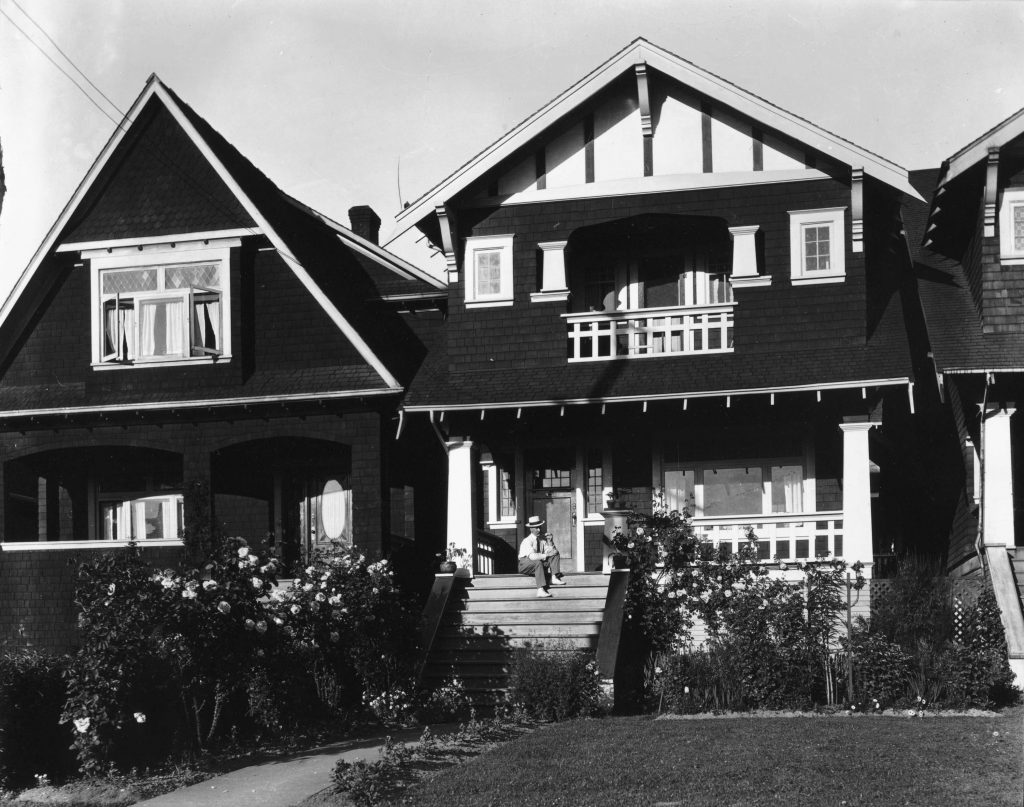
Houses in Kitsilano. Reference code: AM1535-: CVA 99-1347
The ideal for every house history researcher is to find an old photograph of his or her house in the Archives’ holdings. I hate to burst their bubble, but this often doesn’t happen. However, it is feasible to find photographs of the neighbourhood, which often give a sense of what the area was like throughout the years.
A concerted effort has been made to scan and describe much of our street and neighbourhood photographs. These digitized images can be found from the comfort of your home through our online database. Knowing how to search for these photographs, however, does take a bit of creative thinking and practice. Simply typing in an address or street name into the search bar won’t bring up the masses of results one might have been expecting or in most cases, any results. This is where I recommend a pause from the computer, grabbing some scrap paper and a pencil and brainstorming different search terms.
Although we likely don’t have a photograph described by the exact address of the house in question, it is always worth a shot to start by using the house address as a first search term. Other potential search terms could be the street name (and variations e.g. 6th Avenue, 6 Avenue, Sixth Avenue, etc.*), other local streets (particularly the cross streets), nearby commercial districts (e.g. 4th Avenue), the name of the neighbourhood (e.g. Kitsilano), as well as nearby landmarks or well-known buildings (e.g. British Columbia Electric Railway).
It is always good idea to keep track of search terms, because as much as I may think I will remember what ones I have tried, often I do not. Also, when it comes time to search our database it can be helpful to note how photographs are described, which can help refine or expand your search terms.
For street names, it is also a good idea to double check Elizabeth Walker’s Street Names of Vancouver to see if the streets being searched ever went by any other names. If so, then there are a few more search terms to add to the list.
For 2116 Maple Street, my initial search terms list include:
| Address | 2116 Maple Street |
| Street | Maple Street |
| Cross Streets | 6th Avenue 6 Avenue Sixth Avenue 5th Avenue 5 Avenue Fifth Avenue |
| Main nearby roads & commercial districts | 4th Avenue 4 Avenue Fourth Avenue Burrard Street Arbutus Street Broadway |
| Nearby landmarks, well-known buildings, etc. | C.P. Rail C.P. Railway British Columbia Electric Railway BCER B.C.E.R. |
| Neighbourhood | Kitsilano |
Note that we will usually write out the words “avenue” and “street” in full in the description of the photographs, but not always; and sometimes either will be plural.
Now it is time to hit our database. I click in the search bar, and then click on “Advanced search”.

With Advanced search, I can choose to filter the results of my search to photographs, by clicking on the “General material designation” and choosing “Photograph”. I can also limit my search results to a certain date range.
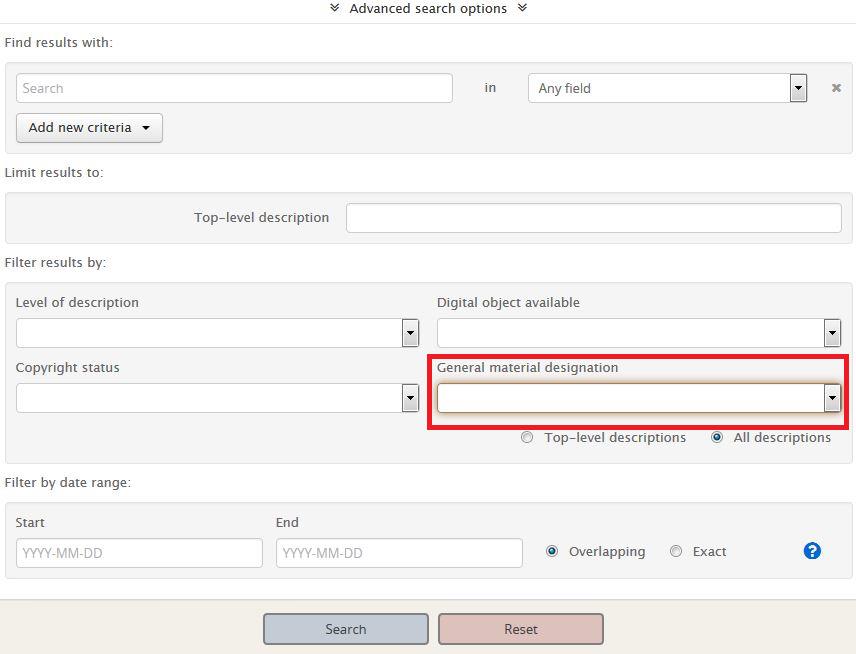
In the “Search” box, I will insert the first of the search terms. I must use quotation marks around the term if it is made up of multiple words. For example, I will search “Maple Street”, not Maple Street. If I forget to use quotation marks, the database will return all results with the word “maple”, and all the results with the word “street” in it. Instead of getting 53 results, I will get 20,931 results, most of which I don’t want.
I now am ready to start my search. I start with the address, “2116 Maple Street” and, as luck would have it, 1 photograph turns up. This doesn’t happen often, and actually, I was quite shocked there is a photograph. I have looked into a number of house histories, and this is the first time where there was a direct hit. This photograph is from 1985, which is interesting, but I also would like to get a sense of what the house and neighbourhood was like further back in time. This is what the next search terms will hopefully help me discover.
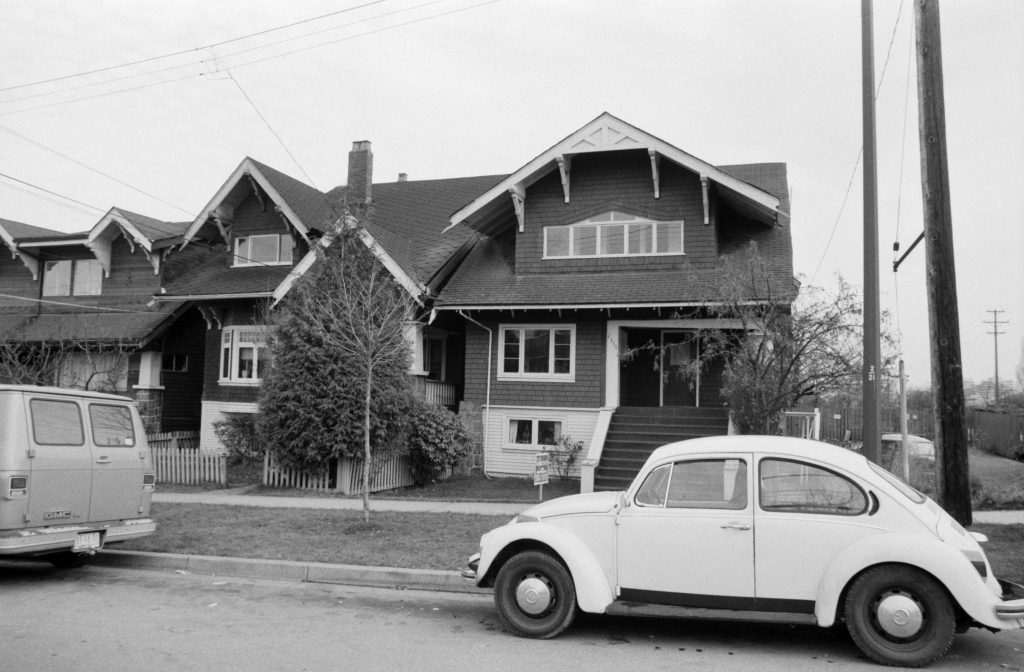
Caption: 2116 Maple Street as it was in 1985. Reference code: COV-S639-1-F49-: CVA 790-1512
As I work my way through the various search terms, along with a visual scan of the thumbnails and descriptions, I find another photograph of the house from 1978. The search also brings up an aerial photograph from 1956 (which is like an early version of Google maps) and two photographs taken at the corner of 6th Avenue and Maple Street in 1900, and one in 1906, before the house was built.
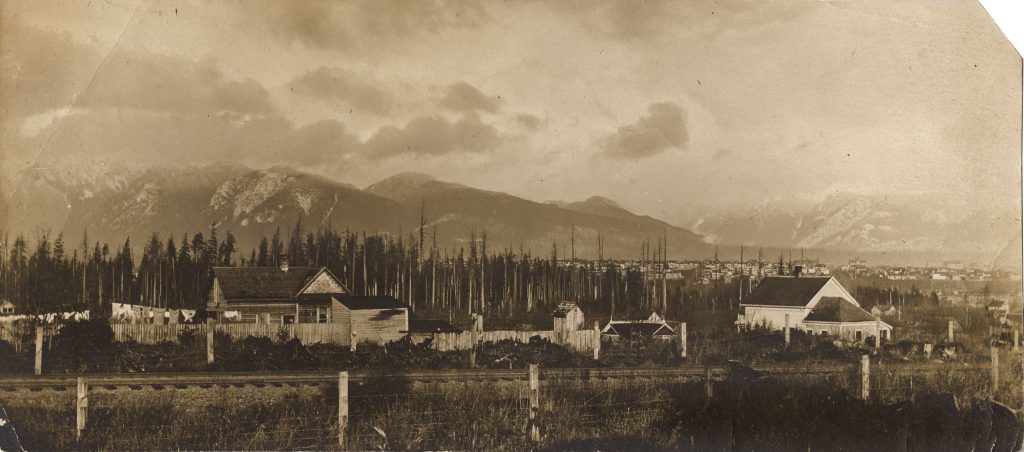
View from 6th Avenue and Maple Street, 1900. Reference code: AM1376-: CVA 135-16
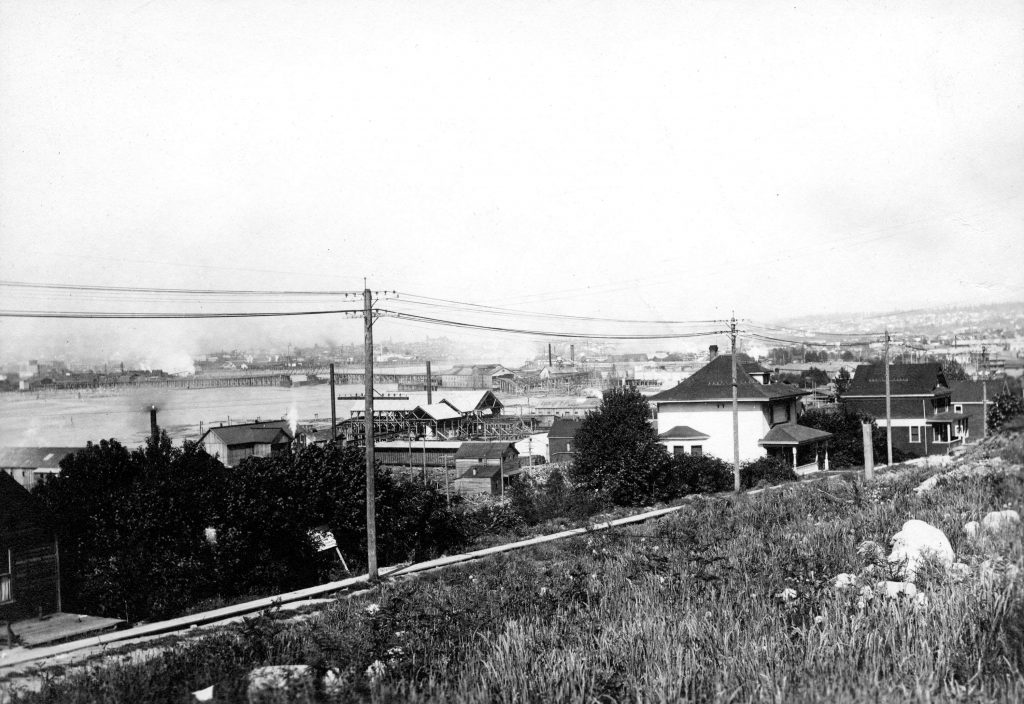
The corner of 6th Avenue and Maple Street looking north east, 1906. Reference code: AM1376-: CVA 135-13
It also locates a photograph of somewhere along Maple Street the year the house was built.
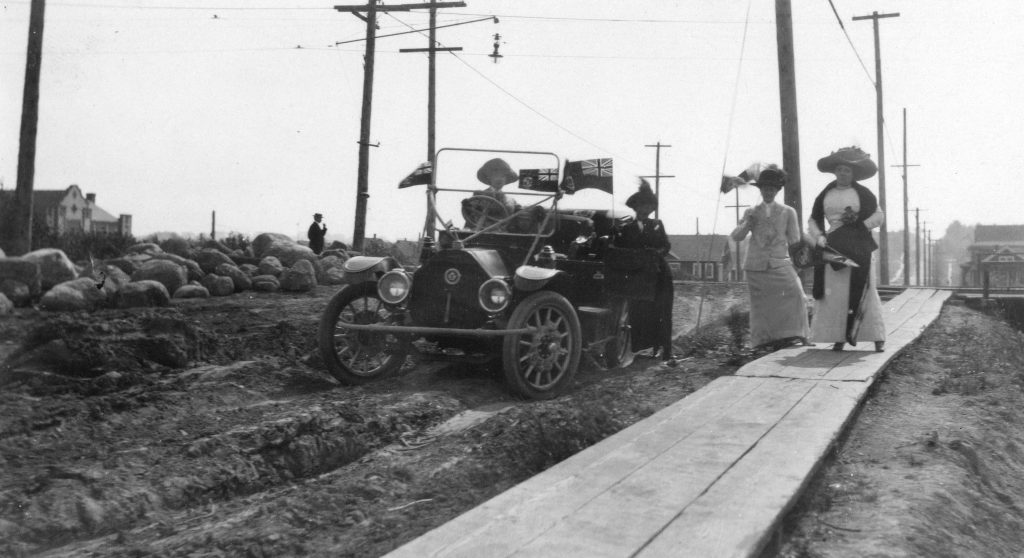
A car on unpaved Maple Street, 1912. Reference code: AM54-S4-: Str P90.08
And it finds a view of the city taken from a biplane in 1919 (where the house can be located).
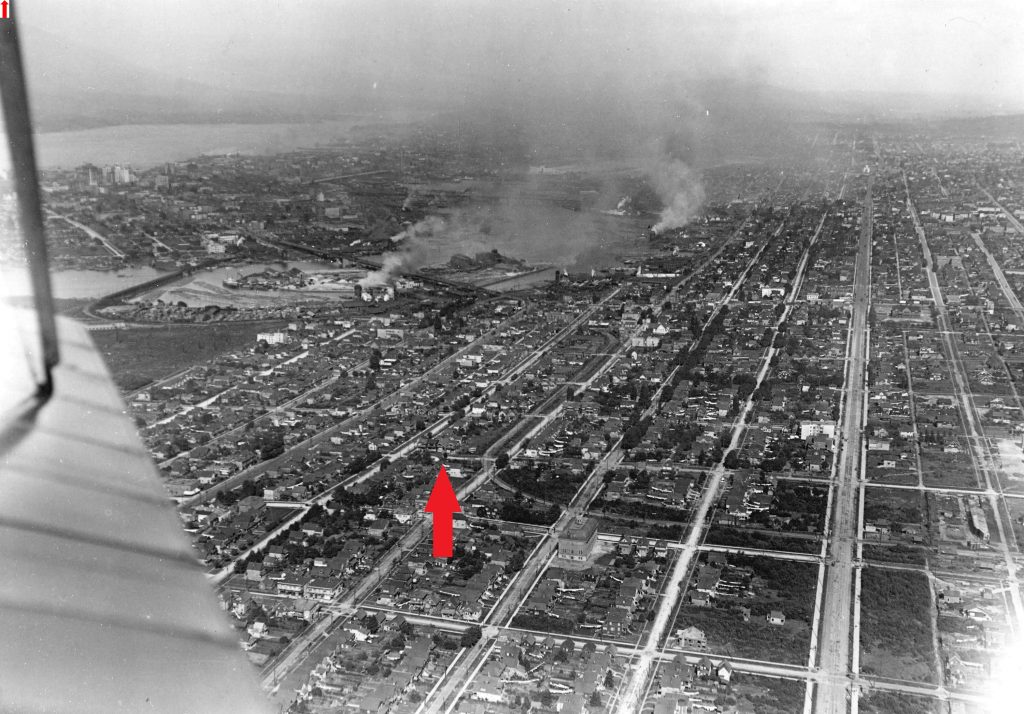
View of Vancouver in 1919 from a biplane with arrow pointing to 2116 Maple Street. Reference code: AM1535-S1-: CVA 1123-4
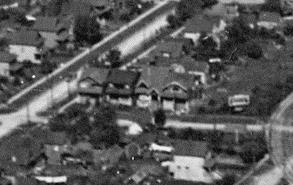
A zoomed in view of the above photograph, showing 2116 Maple Street, 1919.
This last example is where the house is not in the photograph’s description (it was found under the search term “B.C.E.R.”), but the house can be located in it.
Searching through photographs can be time consuming, but it does give me a better sense of the neighbourhood through time. Here are some other interesting photographs of the Kitsilano neighbourhood, which provide me a visual of what the neighbourhood looked like in the past, which helps place the house in a larger historical context.
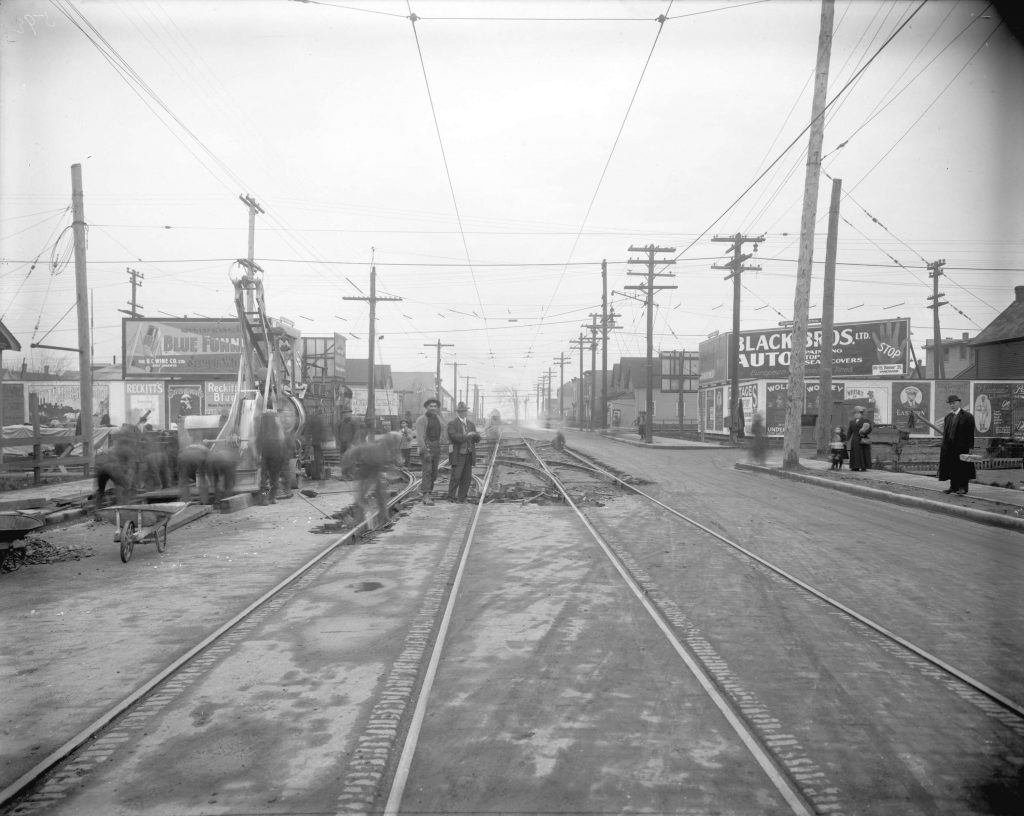
Men excavating street and laying streetcar tracks on 4th Avenue, looking east from Fir Street, ~1913, a year after the house was built. Reference code: AM54-S4-: LGN 1002
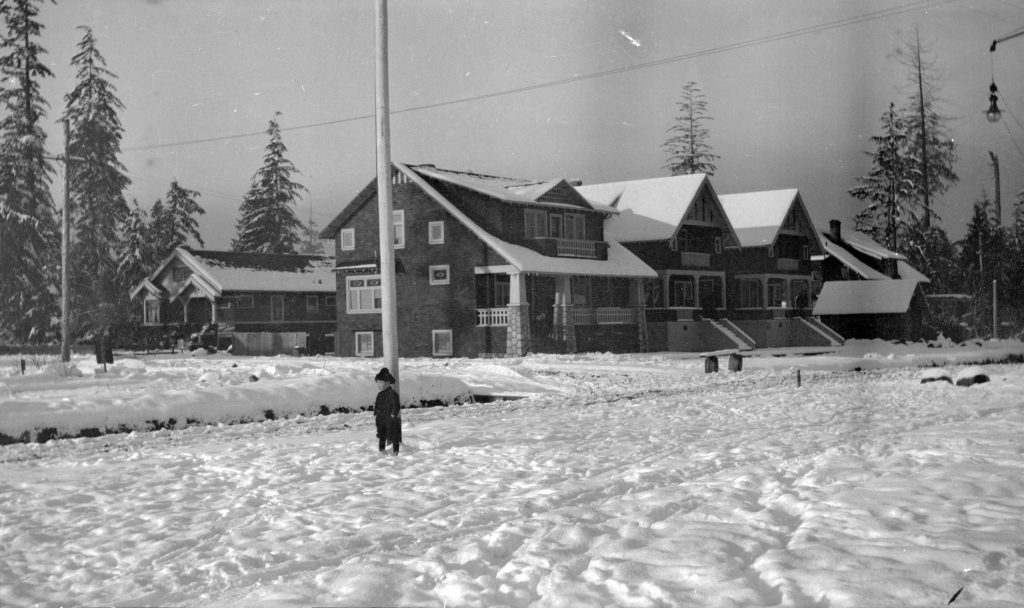
Other Kitsilano houses (3400 block of West 1st Avenue) around the time the house at 2116 Maple Street was being built, 1910-1911. Reference code: AM1584-: CVA 7-61
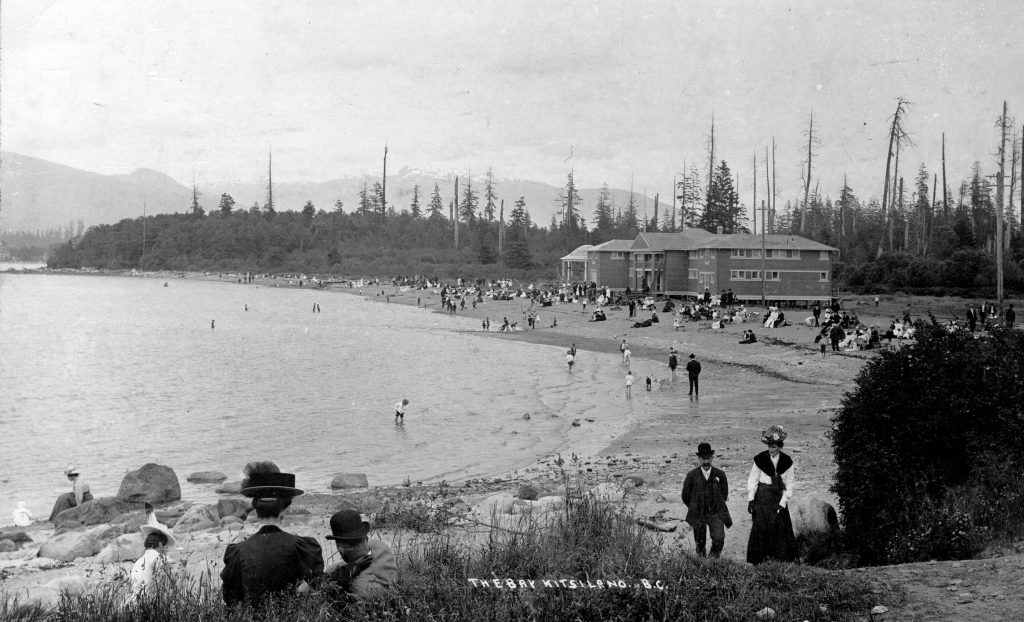
Kitsilano Beach in 1909, three years before 2116 Maple Street was built. Reference code: AM54-S4-: Be P122
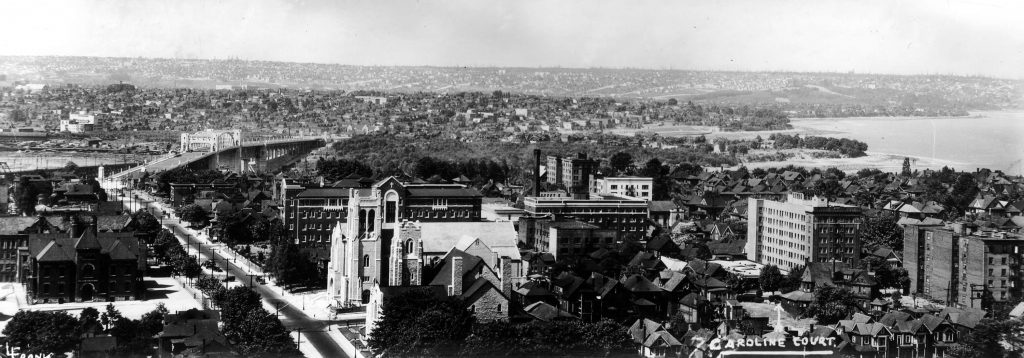
View of Kitsilano, looking south from downtown, 1932. Reference code: AM1376-: CVA 281-1
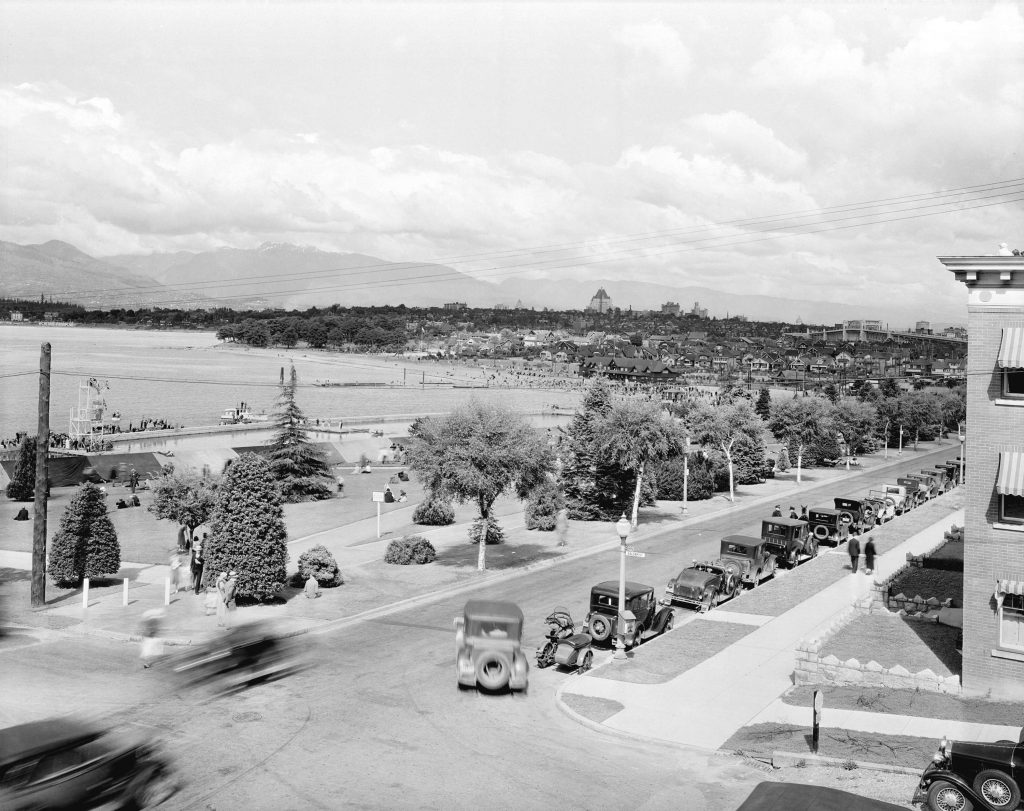
View of Kitsilano swimming pool and beach looking northeast from the corner of Cornwall Avenue and Balsam Street. Reference code: AM54-S4-: Be N5
Now that I have a visual of what Kitsilano was like in the first few decades that the house existed, it is time to search for names of the people who occupied the house through the years, and for that, I will use the city directories. Stay tuned.
Claude Pepper’s Vision of Treating Alzheimer’s Disease Continues into the 21st Century

Claude Pepper Library Collection, Series: 302A, Box 26, Folder 2
Many remember Senator Claude Pepper as the “nation’s spokesman for the elderly,” serving as a chairman of the U.S. House Subcommittee on Health and Long-term care and the House Select Committee on Aging during the 1970s. Pepper gained recognition for being instrumental in displaying such a perpetual commitment to ensuring affordable access to comprehensive healthcare and solidifying social security benefits and Medicare/Medicaid. Remarkably, he expanded the spectrum of public health through the establishment of ten research centers to reduce the pervasiveness of chronic illnesses, such as Alzheimer’s disease, in an effort to reduce the exacerbation of symptoms.
Today, Alzheimer’s Disease (AD) is the sixth leading cause of death in the United States. In fact, Alzheimer’s is the most common cause of dementia among older adults. Many individuals who are affected by the disease experience early onset in their 40s or 50s, while the majority of populations are diagnosed at 65 and up. Although this chronic illness entails complexities to why it occurs, there are several risk factors that precipitate the presence of developing dementia. These conditions include: head trauma, genetics, age, diet, or family history. The U.S. National Institutes of Health reported, that diabetes mellitus, smoking, depression, mental inactivity, physical inactivity and poor diet are associated with increased risk of developing dementia. For example, diabetes can increase the risk of AD by affecting the AB accumulation in the brain, causing the brain to compete for insulin-degrading enzymes. Other studies reveal that hypertension increases the risk of Alzheimer’s disease by 50% by decreasing the vascular integrity of the blood-brain barrier, resulting in protein extravasation into brain tissue. Furthermore, the Alzheimer’s Association (2018) revealed that 35% of Alzheimer’s or dementia caregivers reported that their health got worse over time due to care responsibilities, compared to 19% of caregivers for older people without dementia. Primarily, this disease not only affects families but the healthcare system as well by prevailing as the most expensive disease in America, costing more than cancer and heart disease to treat. In 2017, the direct costs to American society of caring for those with Alzheimer’s and other dementia’s estimated 259 billion (The Alzheimer’s Association, 2018).
These statistics are staggering, which is why Senator Claude Pepper worked tirelessly to sponsor legislation to fund research efforts to create intervention therapies to alter cognitive decline. As a result, his legacy continues today as policymakers partner with IT technologist to treat the disease through the development of assisted technologies. These web-based interventions are beginning to change the paradigm of Alzheimer’s care by offering real-time access to clinicians via a patient portal or mobile app in order to provide care plans and disease management support in the home. Thus, aiding to lighten the burden of caregivers and improve the safety of dementia patients by modifying behavioral and psychiatric symptoms. (Lancioni, Singh, O’Reilly, Sigafoos, Amico, Renna and Pinto, 2016).
Pepper’s vision of improving home health care to enhance the quality of life for the disabled and elderly is beginning to resonate in the healthcare industry. Consequently, empowering dementia patients and caregivers in achieving self-efficacy. Even though e-health tools are changing the dynamic of dementia treatment, awareness and financial provisions are still necessary to broaden the scope of accessing these applications. If you are a student or faculty member who may be interested in learning more about Senator Pepper’s work or the implementation of healthcare policies in government, visit the Claude Pepper Library!
The Claude Pepper Library & Museum offers insight into the establishment of medical research centers as well as the National Institutes of health on behalf of Senator Pepper’s instrumental legislative work. These materials are available for researchers and can be discovered online through the collection’s finding aid.
Opprobrious Epithets and Cherry Rum

This week, I’d like to draw your attention to a fascinating collection that was recently digitized and made available in Amherst College Digital Collections: the Amherst College Early History Manuscripts and Pamphlets Collection.

A map of South College from the first year of the college’s existence, 1821/22, showing the students living in each room.
This is a small collection of documents that were donated to the archives by Edward and Ethel Mellon in 1921 (see the finding aid here). The majority of the items in this collection date from the first fifteen years of Amherst College’s existence and they reveal a lot about what the institution was like during this formative time. The college was very small: admissions, financial aid, discipline and the day to day business of the college where executed in a personal and paternal manner by the President and the Board of Trustees. There are many letters in the collection regarding students wishing to attend the college. Admission was often as simple as a letter of introduction sent to the President and a letter of acceptance in return. The college having been founded for the express purpose of educating indigent young men of piety, there are also many inquiries about financial aid.

“He wishes to ascertain the principal expenses, (viz.) the price of board, firewood, etc. and likewise what assistance can be afforded to pious indigent students who possess the requisite talents.” Dana Clayes letter to President Heman Humphrey, June 21, 1824
The college was also rigidly paternalistic in its early years – absolute obedience and unquestioning respect was required of all students and the faculty, president and trustees of the college dictated most aspects of student life. The eleven items relating to student discipline illuminate this dynamic very well. Ethraim Eveleth, class of 1825, was suspended for implying that the faculty had displayed favoritism in student appointments, the collection includes his signed retraction and a statement by the trustees reinstating him as a student in light of same. Another suspension was given to Joseph Goffe, Jr., class of 1826, who left campus without permission and then had the temerity to say that a student has the right to disobey the authority of the College when he thinks his request has been unreasonably denied.

Charles Upham Shephard apparently made “an opprobrious inscription upon glass + circulating it in the Chemical Lecture room” received an Admonition from the president.
Some of the offenses that student received discipline for make more sense to a modern mind: Charles Upham Shephard, class of 1824 and later a respected professor of Natural History at the college for many decades, was admonished by the president and faculty for what we would now call bullying.
“The Faculty cannot close without expressing their decided disapprobation of every attempt to bring a fellow student into disconduct or make his college life uncomfortable by applying to him any opprobrious epithet whether directly or indirectly, in conversation or in writing. The Faculty wish to have it distinctly understood that no such violation of the laws of kindness and good breeding can be tolerated in this institution.”
Edward Dickinson, class of 1823, who would go on to be a respected lawyer, treasurer of the college and the father of Emily Dickinson, was involved in an incident in November of 1821 with an oyster supper, cherry rum, gin and a “great disturbance in and about the Institution”.

The Charges: “-that after supper they had cherry rum and gin -that they drank to excess – that about 12 0’clock they all of them came to the Institution – that they there behaved in a very indecent and riotous manner, and made great disturbance in and about the Institution, to the extreme annoyance of those residing in it til one o’clock or later.”
Other items of interest and importance in this collection include:
- Five letters between the Anti-Slavery Society and the Trustees from 1834 regarding the Trustees’ order that the Society disband and the Society’s protest of that decision. These letters and the history of the Society more broadly are explored in another post on this blog, the Amherst College Anti-Slavery Society.
- In February 1822, students presented a petition to President Zephaniah Swift Moore expressing their dissatisfaction with tutor Lucius Fields and their request for a different tutor. In response the faculty passed a resolution that the petition was slanderous and should not be granted. Regarding punishment for the students who brought the petition, the faculty decided to treat the students with “paternal tenderness” but should there be any further disorder or disrespect to the officers of the Institution, the faulty would proceed with all the severity required.
- A letter from Cyrus Grosvenor to President Moore in 1823 discusses his travels in the South Carolina and his attempts to raise money and recruit students for the college there.
- In 1841 or 1842, 10 sophomores agreed to work on the college hill for 10¢ an hour to pay their debts. Presumably this meant manual labor to grade the hill or maintain paths or roads.
- My personal favorite is a letter from the senior class to the president expressing their concern for his health and their willingness to forgo all the rest of their classes with him this term so that he can rest. A wry note by the president is written at the end of the petition indicating that they continued to have class for the rest of the term.
If you enjoy this material, keep your eyes peeled for the Early College History Collection, which is being digitized and will be going up on ACDC in the coming months!
In memory of Dr. Nancy H. Marcus
 We are saddened to hear of Dr. Nancy Marcus’ passing this last Monday.
We are saddened to hear of Dr. Nancy Marcus’ passing this last Monday.
Dr. Marcus served at FSU in several roles for 30 years. During her tenure, she served as the director of the Marine Laboratory, chair of the Department of Oceanography, and as Dean of the Graduate School from 2005 until her retirement in 2017. Dr. Marcus was named a Robert O. Lawton Distinguished Professor in 2001, the highest honor that FSU faculty can award one of their own. Dr. Marcus noted that this award was important to her because it not only recognized her contributions in research and teaching, but also her service to the university.
A pioneer in the field of Oceanography when there were few women in the field, Dr. Marcus worked her entire career to promote diversity in FSU and especially the STEM fields so that others would be allowed the same opportunities to have a rewarding career. She served as the director for FSU women in Math, Science and Engineering to promote women in STEM fields and took every opportunity to advance the cause of women in these disciplines. She even gave up a chance to pursue her own research on copepods (a type of crustacean) to focus in on the advancement of women.
While Dean of the Graduate School, Dr. Marcus set up the Office of Graduate Fellowships and Awards, which provides support to some of FSU’s most bright students. Its main purpose has been to connect students with funding opportunities to pursue an advanced degree. You can read more about her career here from her “Profiles in Leadership” interview last year. http://news.fsu.edu/news/2017/04/25/profiles-leadership-marcus-reflects-30-years-research-students-service/

Heritage & University Archives recently acquired a collection of materials from Dr. Marcus regarding the Task Force on Women’s Faculty Salaries, a task force that she participated in. Those interested in learning more about Dr. Marcus and the collection should contact Heritage & University Archives by emailing Sandra Varry at svarry@fsu.edu.
Rebuilding in the Post-War Years: The Legacy of the Hasterlik-Hine Collection
This is the final blog post from the students in charge of the Hasterlik-Hine Digitization Project in cooperation with the Institute of World War II and the Human Experience.
Written from 1945-1948, the final portion of the digitized portion of the Hasterlik-Hine collection offers an invaluable glimpse into life after World War II. Excitement over Giulia Koritschoner’s upcoming trip to the United States characterizes many of the post-war letters, as does joy about reconnecting with the family friends that the Hasterlik-Hine family had lost contact with during the war.
However, the most prominent aspect of the final portion of the collection is the numerous insights it offers into the difficulties that accompanied post-war life in Austria. Supplies were so scarce that “people had to fetch water in buckets an hour away on foot after having stood in line for an hour” and had to “take long walks in the woods to find small pieces of wood to have a little bit of heat.” Yet, perceptions of the former Axis powers varied dramatically. Mia felt pity for those living in these countries, expressing sadness that individuals were “starving” in Vienna while those in the United States were “suffocating in superabundance.” Others, however, only expressed contempt for the former Axis powers, even stating that they did not see the point of sending rations and supplies to “enemies who should starve to death.”
The one consensus among all parties seemed to be the dramatic nature of the occupation of Austria by Allied forces after the war, which was so severe that it seemed as if “all the nations have sent their soldiers to Vienna.” However, even in Vienna, life would, eventually, return to normal. In a letter from March of 1946, Boni celebrated the future of Vienna, writing, “Surely the people will tell you… about Vienna. About ruins and hunger, about cold rooms and deserted streets, about demoralization and despair. All that is also true here. But alongside that are also attractive things. People who want to live well, who certainly feel themselves to be unfortunate, but who are interested in the tragedies and little jokes of the greater evolution of things…”

Reflecting the tenacity, resilience, and hope for the future that characterizes the Hasterlik-Hine collection, Boni’s letter exemplifies the sentiments upon which many of the survivors of World War II ultimately constructed their futures. Giulia’s letters to childhood friends such as Ellen Christansen and Lisl Urbantschitsch transformed from letters filled with cartoons that complained about teachers to letters that reflected exciting plans for the future. While Giulia discussed her upcoming trip to the United States, Lisl shared her plans to emigrate to California and live with her father. Developing an increased sense of independence throughout the post-war years, Lisl would employ her artistic talent in order to secure a lucrative job making puppets. By 1947, Lisl was living in Paris and enjoying her independence.
Giulia’s life was, ultimately, one of joy and success as well. On April 21, 1946, she sailed from Paris, France to New York City, finally reuniting with her mother, Mia Hasterlik, from whom she had been separated for eight years. By 1948, Giulia had married Gerald Hine and was pregnant with their first child. Giulia would return to Vienna for a few years with her husband before living out the rest of her life in the United States. She passed away in 2015 at the age of 90.
A discussion of these letters and letters like it from other troubled times in history will be presented at the Letters in Troubled Times: Evaluation of Epistolary Sources conference on Friday, February 16, 2018, in Tallahassee, Florida. Please contact Dr. Suzanne Sinke at ssinke@fsu.edu about questions regarding the conference.
Taking to the Green
One of the most interesting things about my work is getting to learn things I never thought I would know. Like the fact that, apparently, the golf season in college is all year long with a long break over December and January. Which means, both the men’s and women’s golf teams will be hitting the links again starting this month, the women started their spring season last Friday and then men get up and running today. A perfect time to share the media guides we have digitized featuring past golf squads.

Our collection of golf media guides start with the 1974 team and go up to the 2010 teams. We have a smaller collection of golf than we do for other sports at FSU but these guides still provide a fascinating look at this sport and its history at FSU.
The Emancipation Proclamation
President Abraham Lincoln issued the Emancipation Proclamation on January 1, 1863, as the nation approached its third year of bloody civil war. The proclamation declared “that all persons held as slaves” within the rebellious states “are, and henceforward shall be free.”

Despite this expansive wording, the Emancipation Proclamation was limited in many ways. It applied only to states that had seceded from the United States, leaving slavery untouched in the loyal border states. It also expressly exempted parts of the Confederacy (the Southern secessionist states) that had already come under Northern control. Most important, the freedom it promised depended upon Union (United States) military victory.
Although the Emancipation Proclamation did not end slavery in the nation, it captured the hearts and imagination of millions of Americans and fundamentally transformed the character of the war. After January 1, 1863, every advance of federal troops expanded the domain of freedom. Moreover, the Proclamation announced the acceptance of black men into the Union Army and Navy, enabling the liberated to become liberators. By the end of the war, almost 200,000 black soldiers and sailors had fought for the Union and freedom.
The original of the Emancipation Proclamation of January 1, 1863, is held in the National Archives in Washington, DC. With the text covering five pages the document was originally tied with narrow red and blue ribbons, which were attached to the signature page by a wafered impression of the seal of the United States. Most of the ribbon remains; parts of the seal are still decipherable, but other parts have worn off. For conservation reasons, it can only be displayed for a short amount of time each year.
In celebration of African American History Month, the original Emancipation Proclamation from 1863 will be on a rare special display in the East Rotunda Gallery of the National Archives Building in Washington, DC from February 17 to February 19, 2018 from 10:00 A.M. to 5:30 P.M. each day. Admission is free and open to the public. Learn more about this important document, and view and download high-resolution images of the Emancipation Proclamation in the National Archives Catalog.
Winter Wander in Vanier Park – 2018
This past Saturday, February 3, the sky was its typical overcast winter self, perfect for the seventh annual edition of Winter Wander in Vanier Park.

Winter Wander, a fun family event, is a chance for people to explore the institutions that call Vanier Park home, including Museum of Vancouver, Vancouver Maritime Museum, HR MacMillan Space Centre, City of Vancouver Archives, Vancouver Academy of Music, and Bard on the Beach.
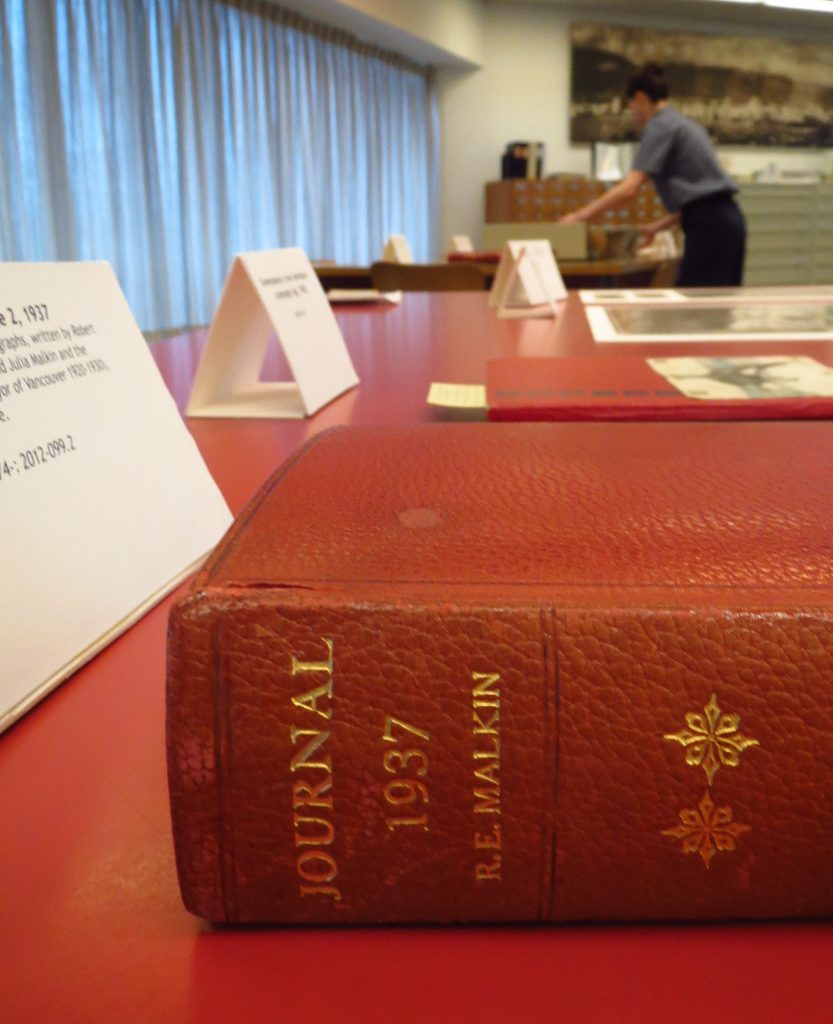
Setting up the records for display before visitors arrive. Photo: Bronwyn Smyth
In the Archives, we welcomed around 300 guests. On display was a sampling of some of our favourite records, and some digitized film playing on the big screen.
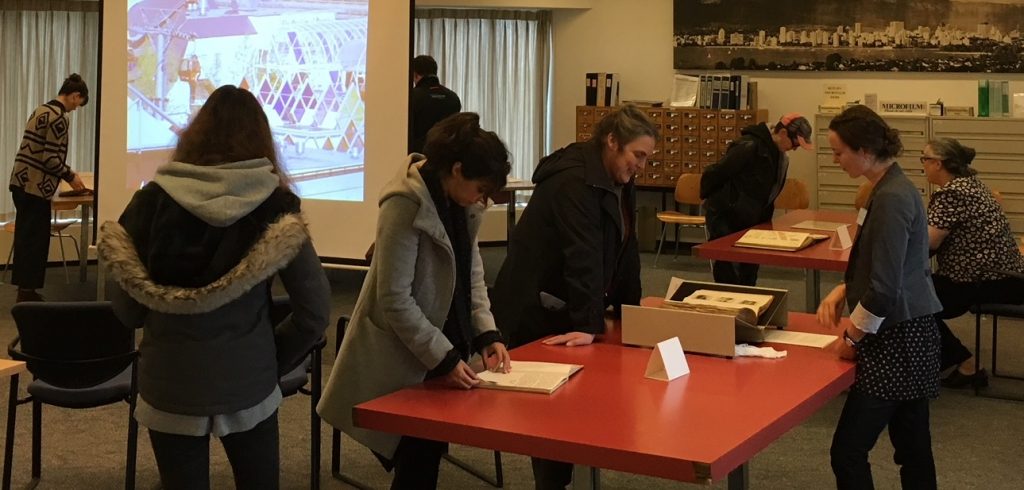
Talking with visitors about the records on display. Photo: Heather Gordon
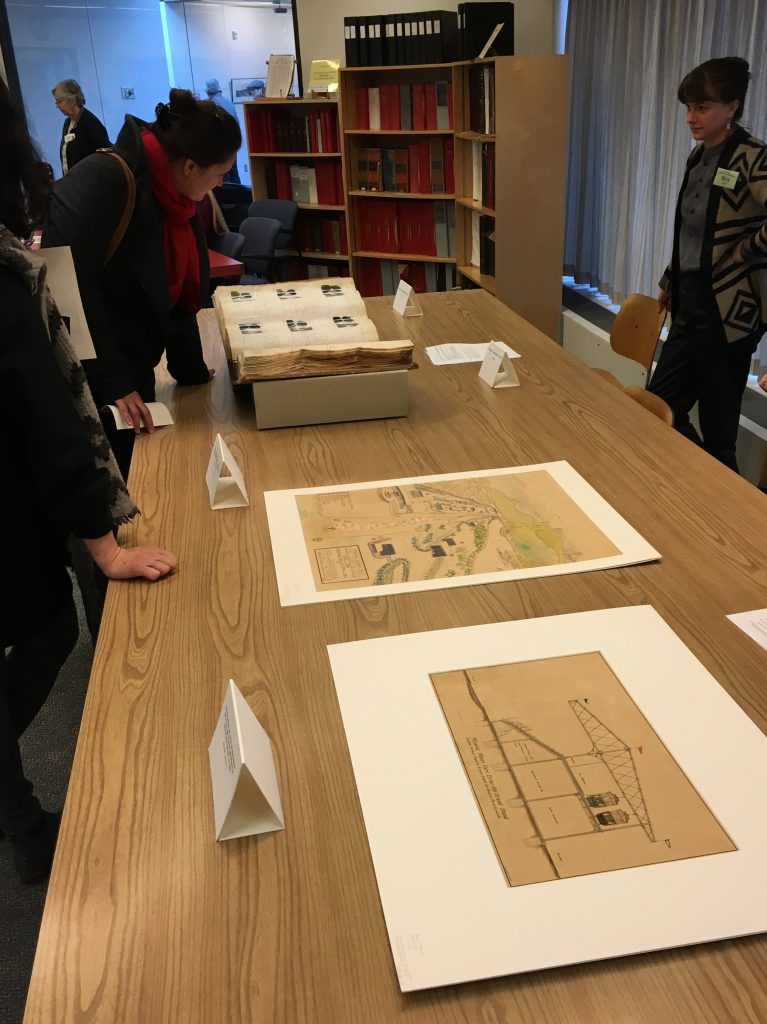
Talking with visitors about the records on display. Photo: Heather Gordon
These records included a range of items: a contract for a Chinese opera singer from 1914, sample letters and a concert ticket from when the Beatles played the PNE, the first Council minute book, and a prisoners’ record book which recently joined the list of publicly available records.
Visitors had the opportunity to get an instant photo portrait taken (remember the kind that develops in front of your eyes?), thanks to the generous loan of instant camera and backdrop from Beau Photo.
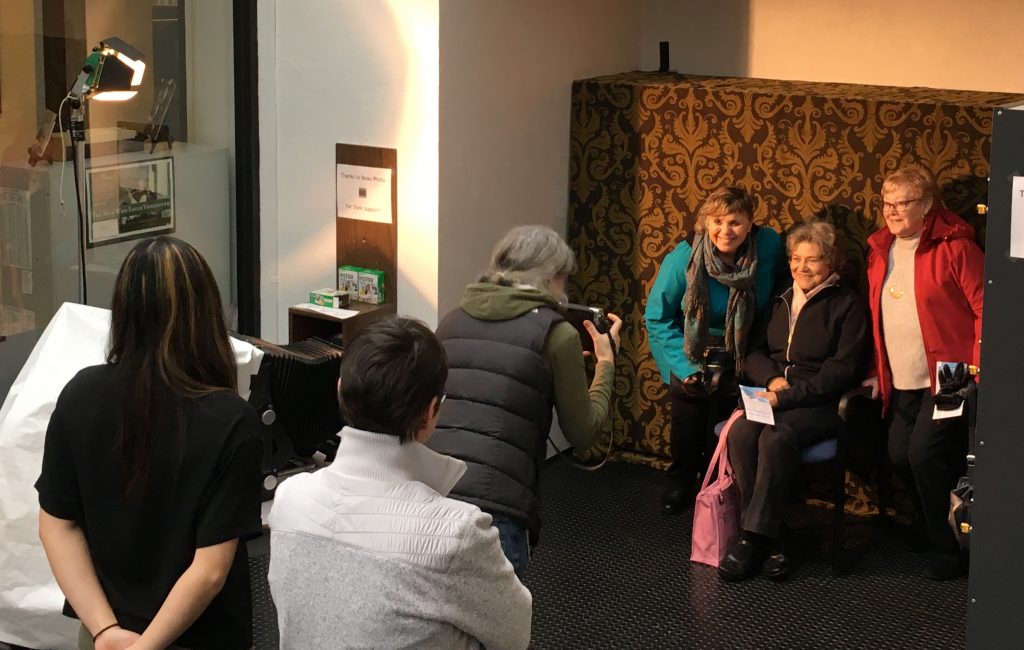
Visitors pose for their instant photo portrait. Photo: Heather Gordon
In addition to taking home a portrait, visitors were also able to select a few copy prints as further mementos of the day. These copy prints were once used as the Archives’ way of providing access to our photograph and negative holdings. With the advent of digitization, we now point researchers to our database where the photographs and negatives that have been digitized can be viewed and downloaded. After visitors selected some prints, they were able to pull up the metadata associated with their chosen copy prints by looking up the reference number pencilled on the back of the print on our database.
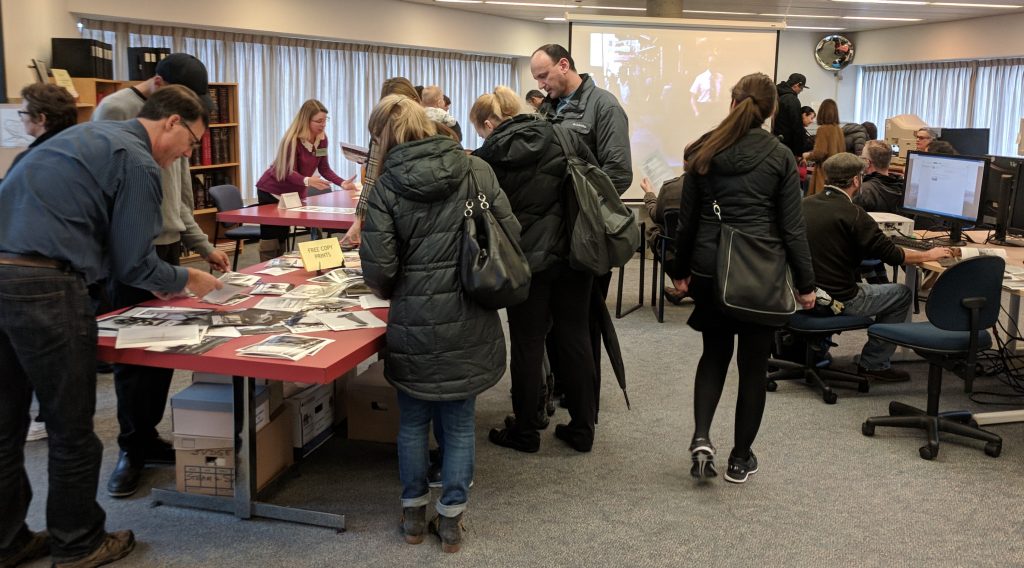
Visitors enjoy choosing copy prints, looking at displayed records, and using our database in the Archives’ Reading Room. Photo: Neal Jennings
It was lovely to welcome so many people, and introduce them to our work at the Archives. Thank you to the Friends of the Vancouver City Archives and other volunteers for helping us make Winter Wander a success.
















